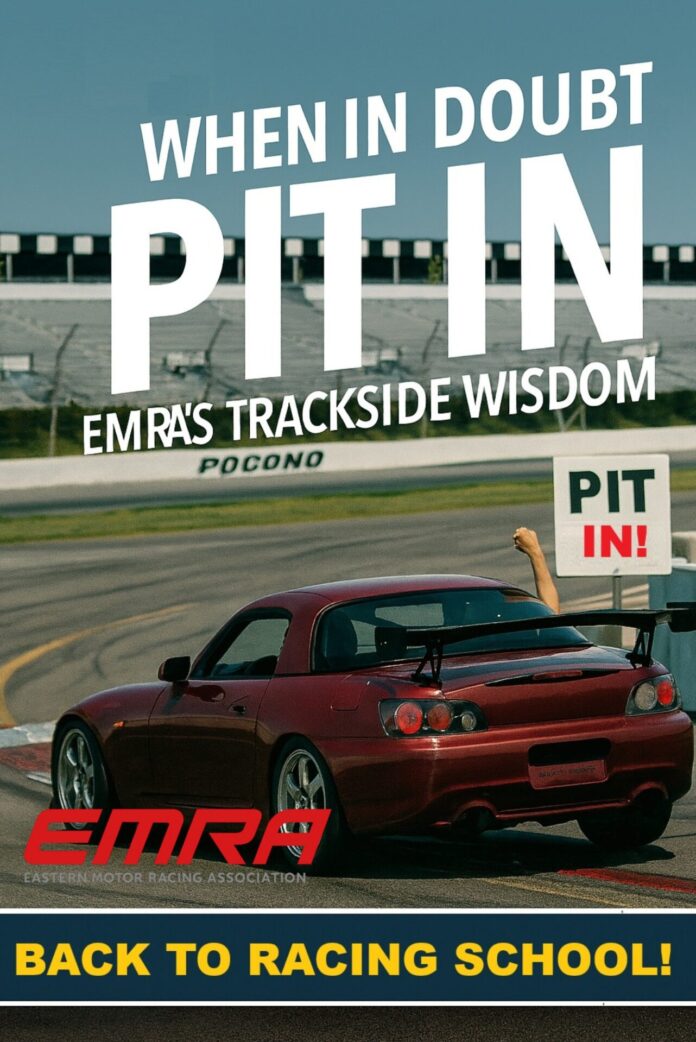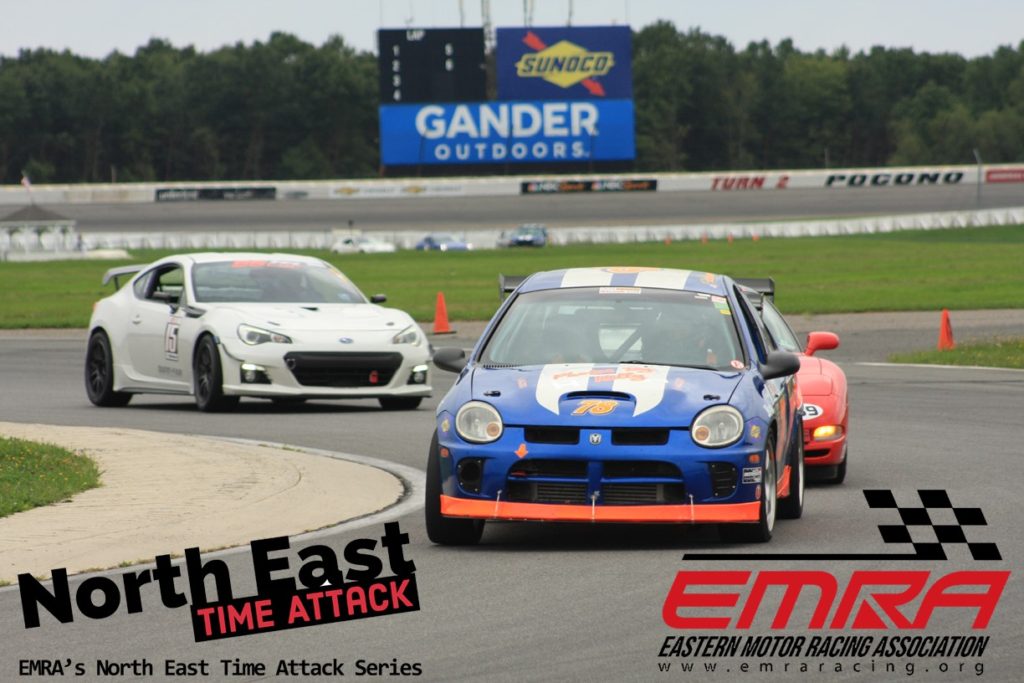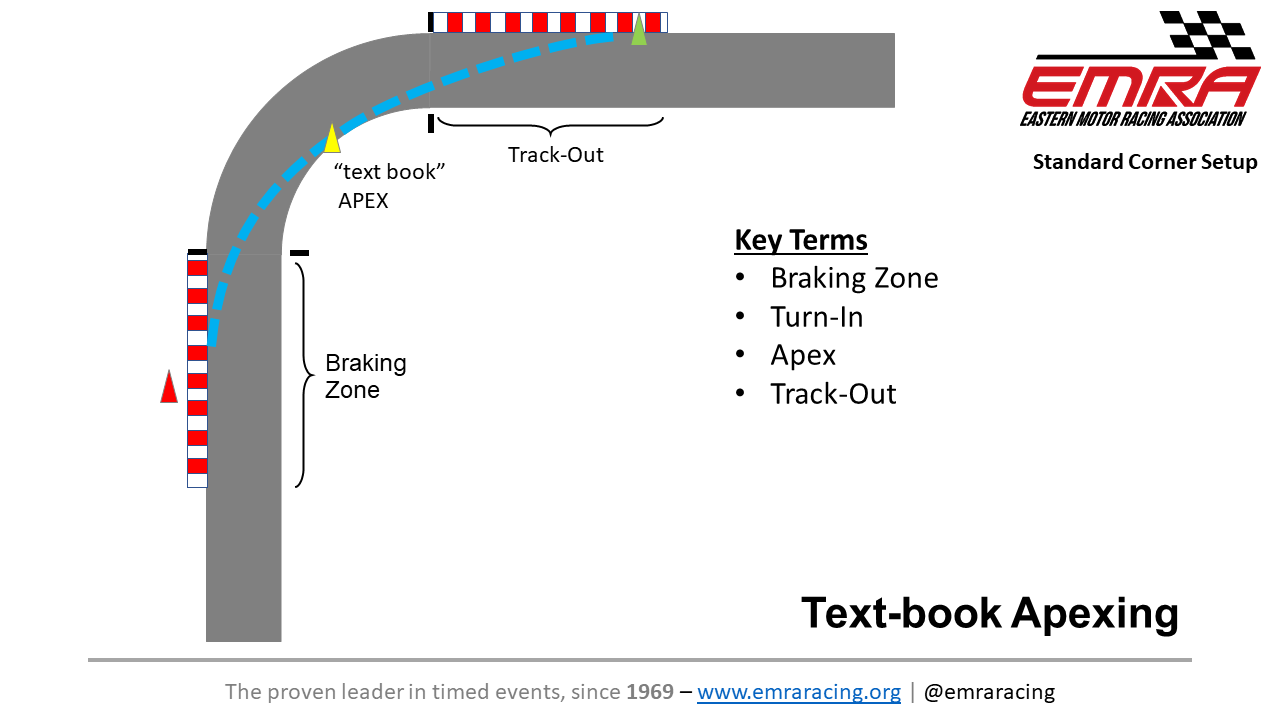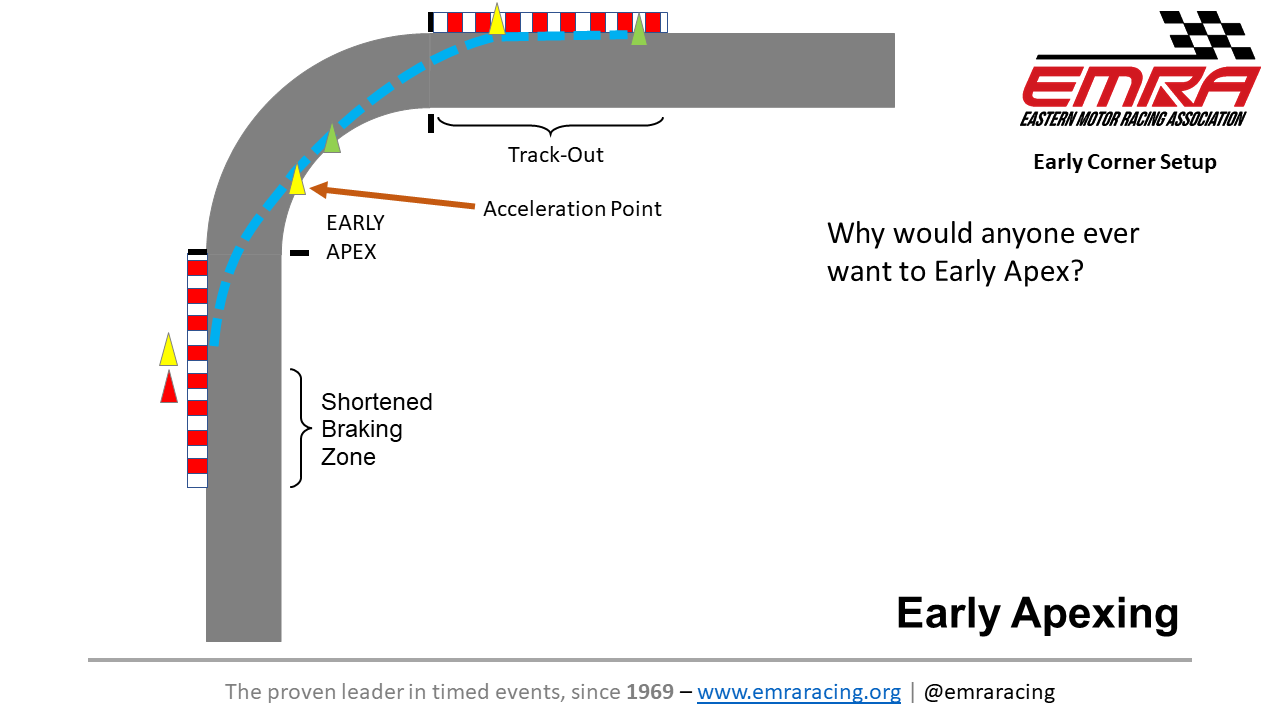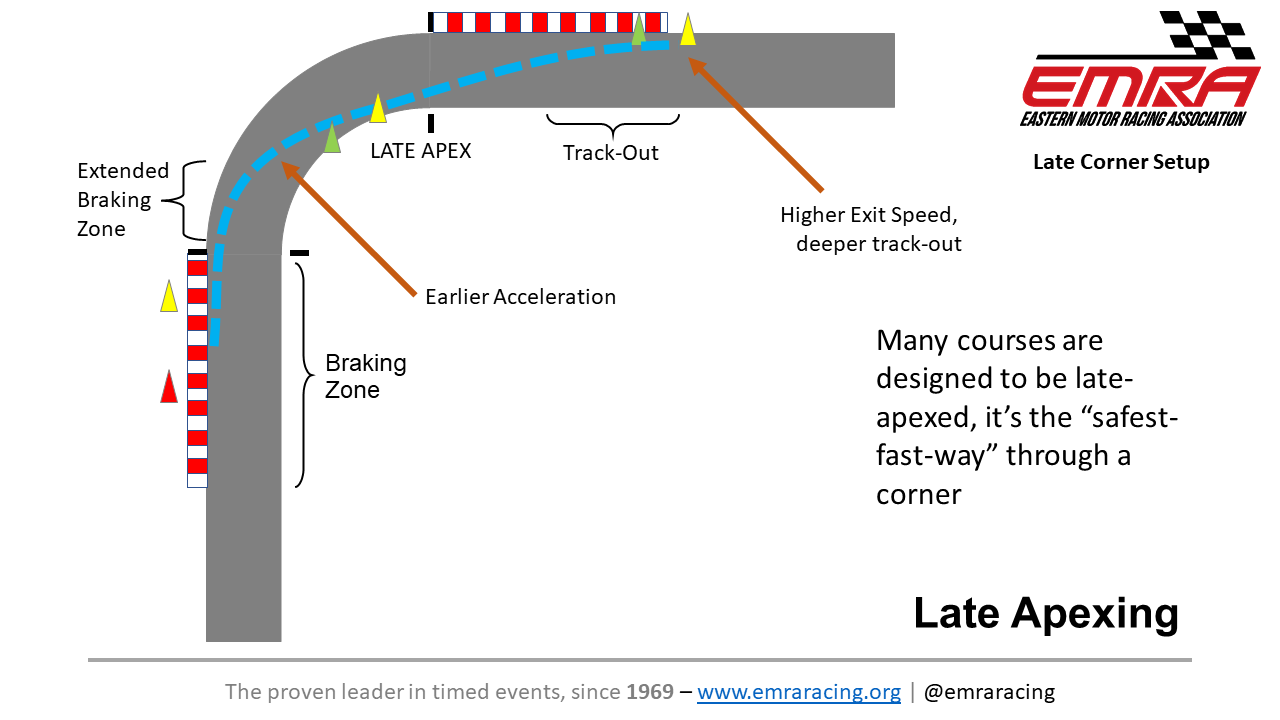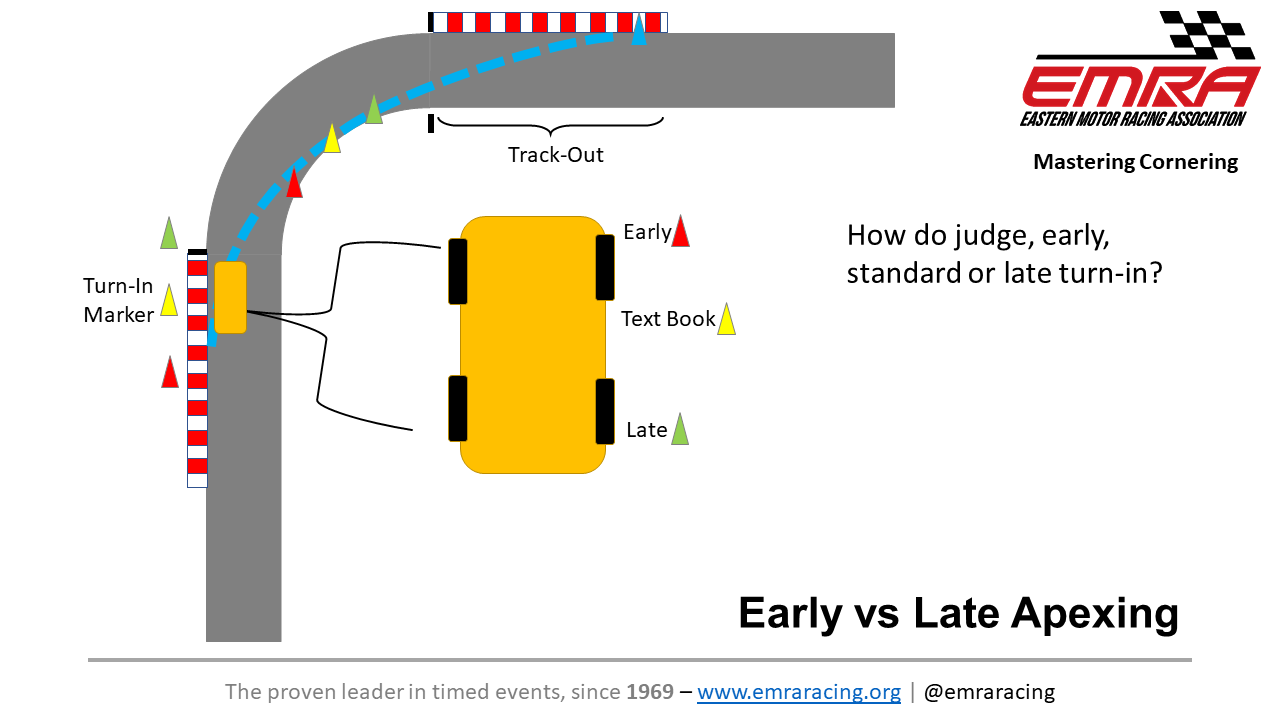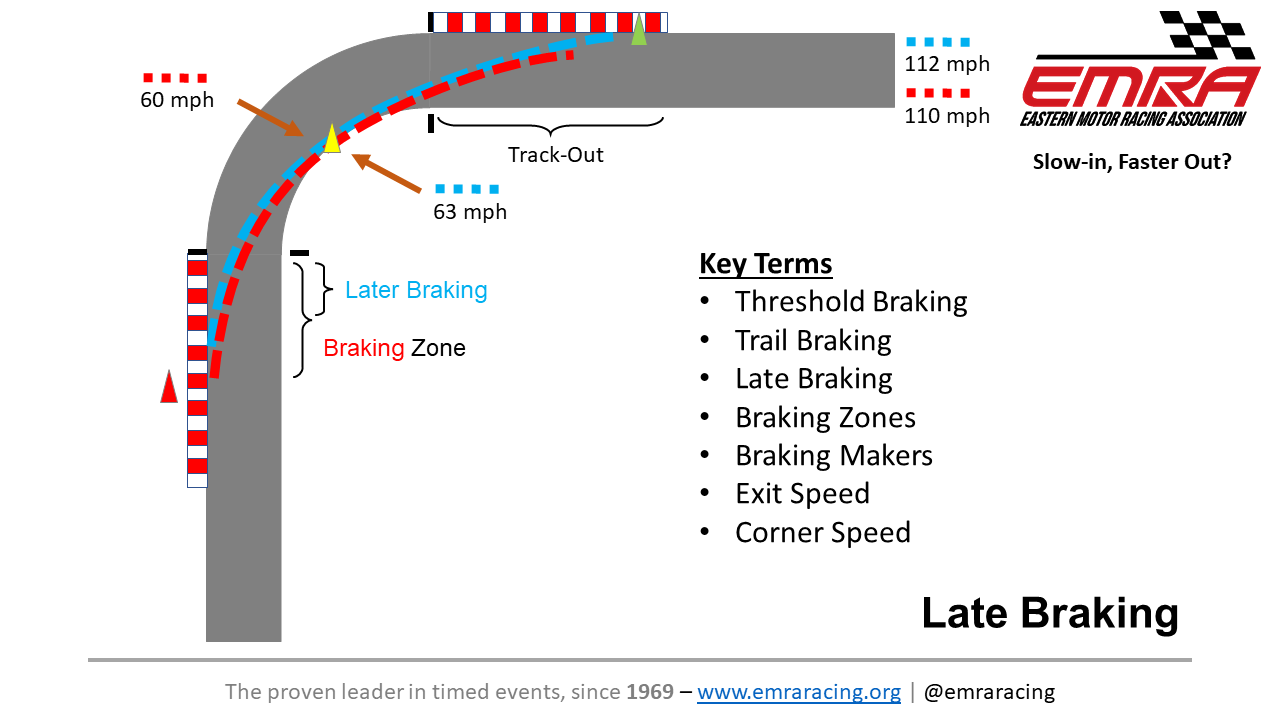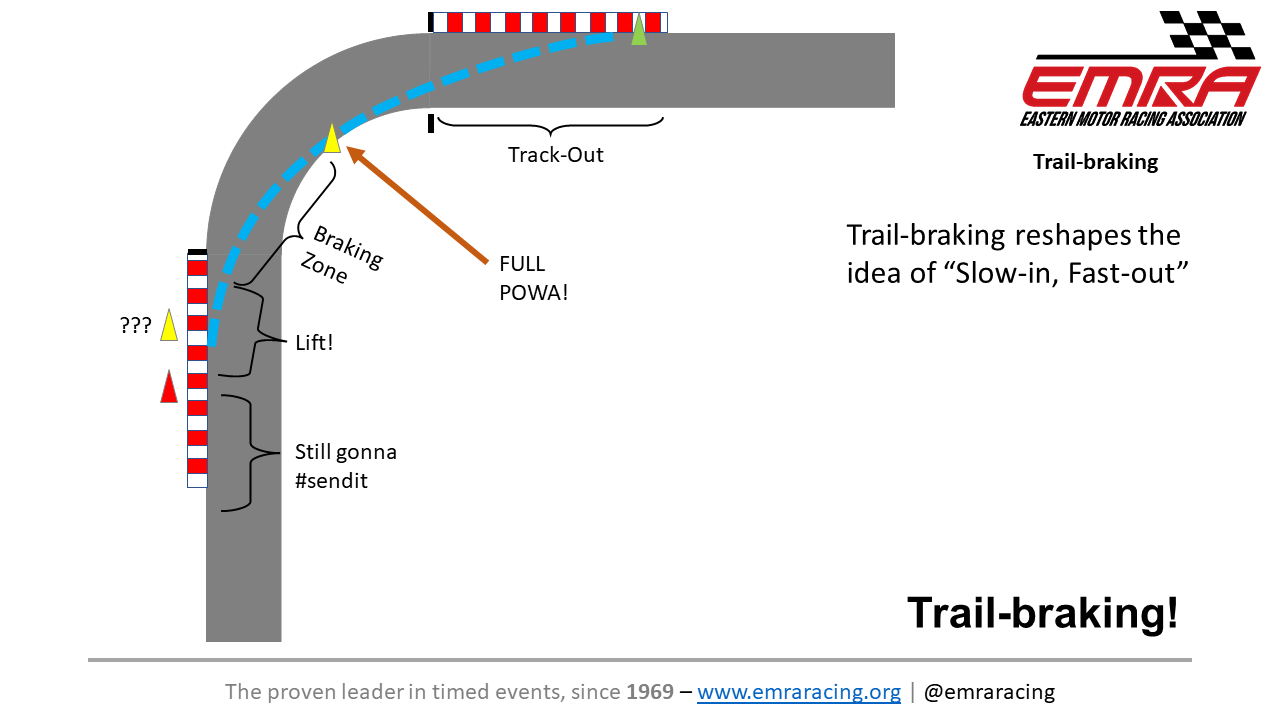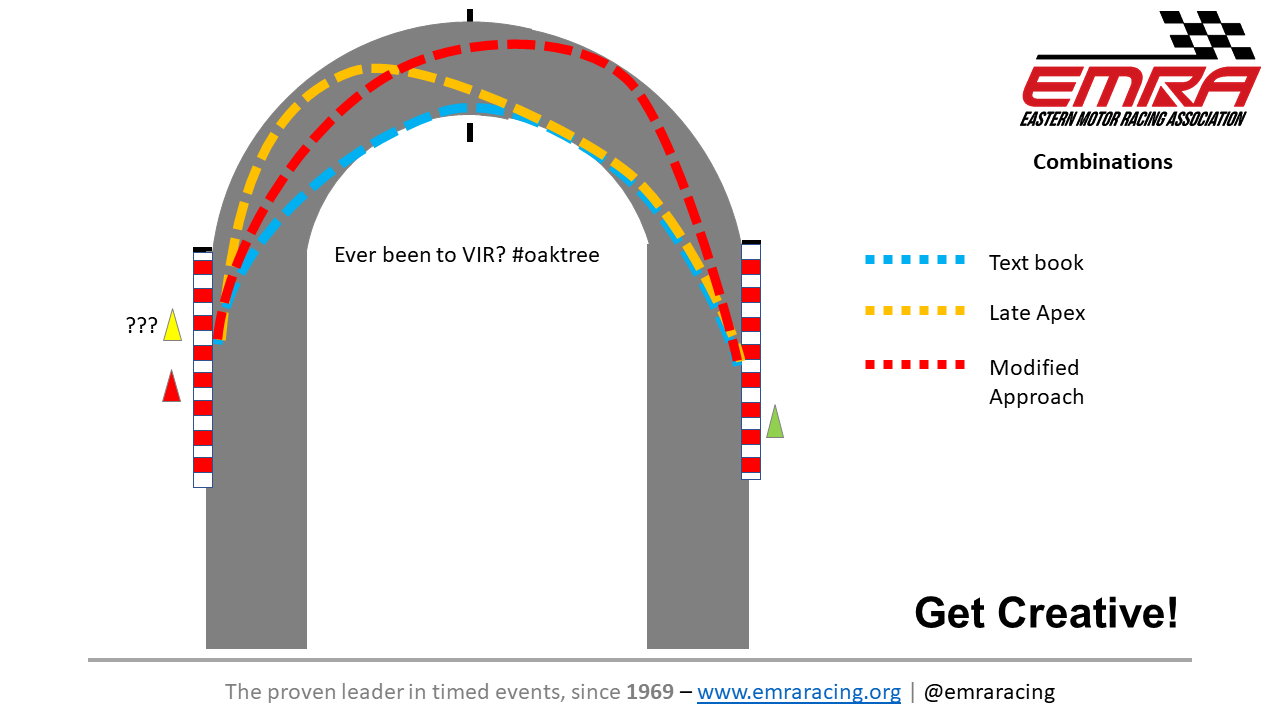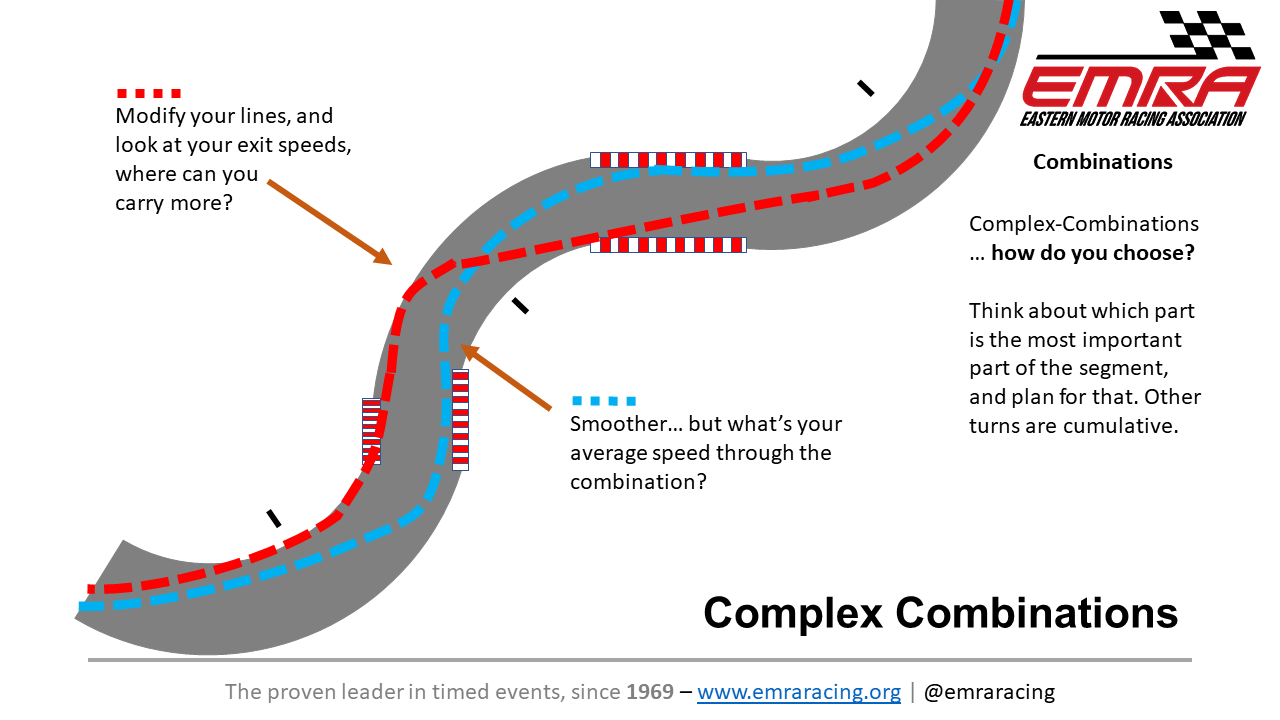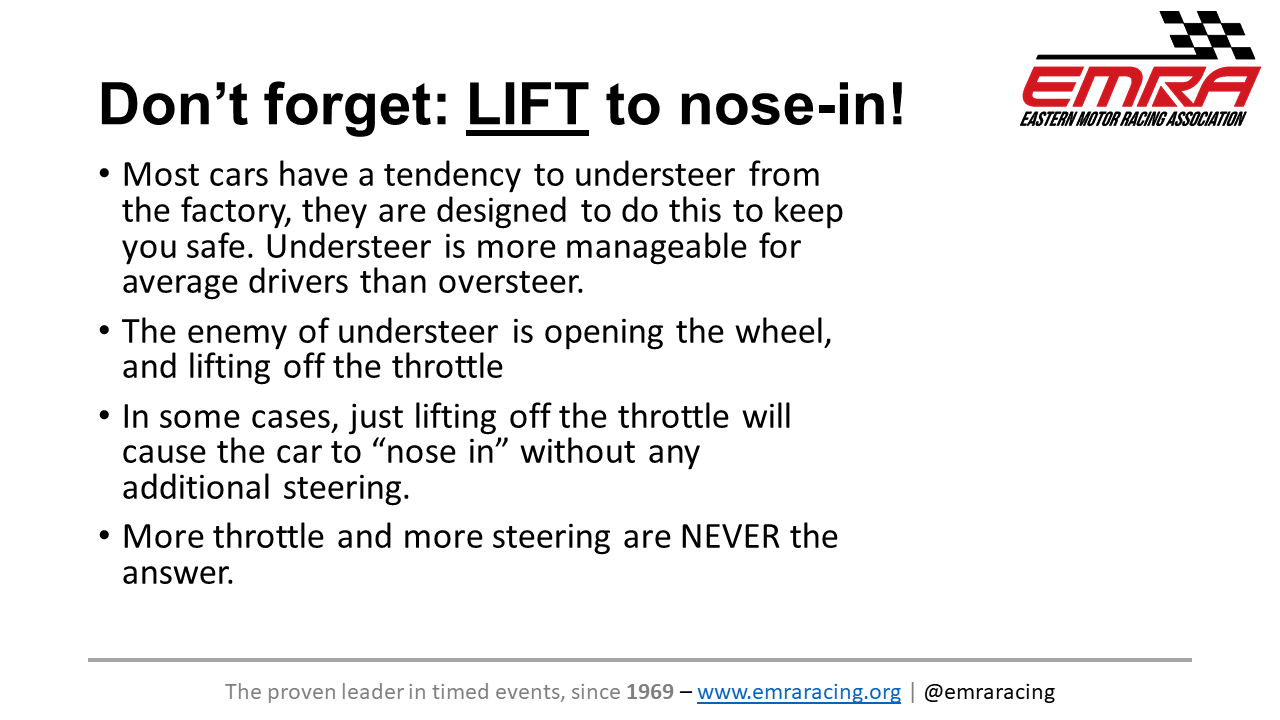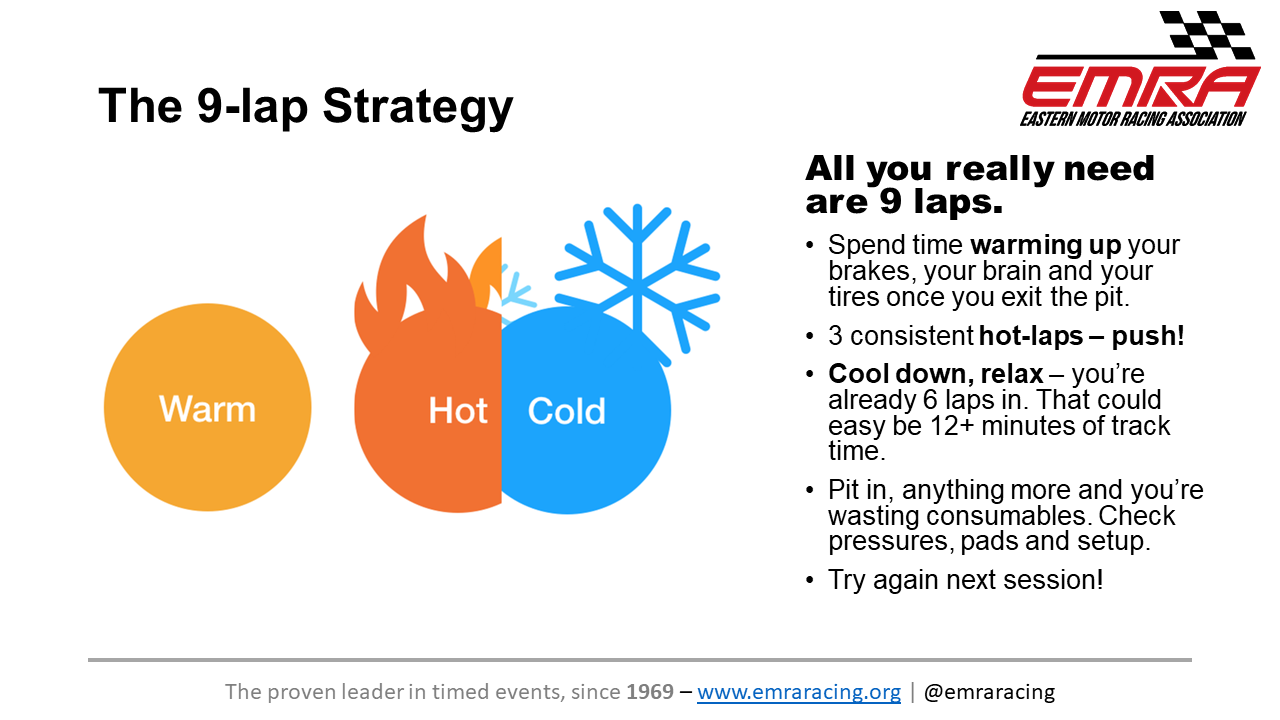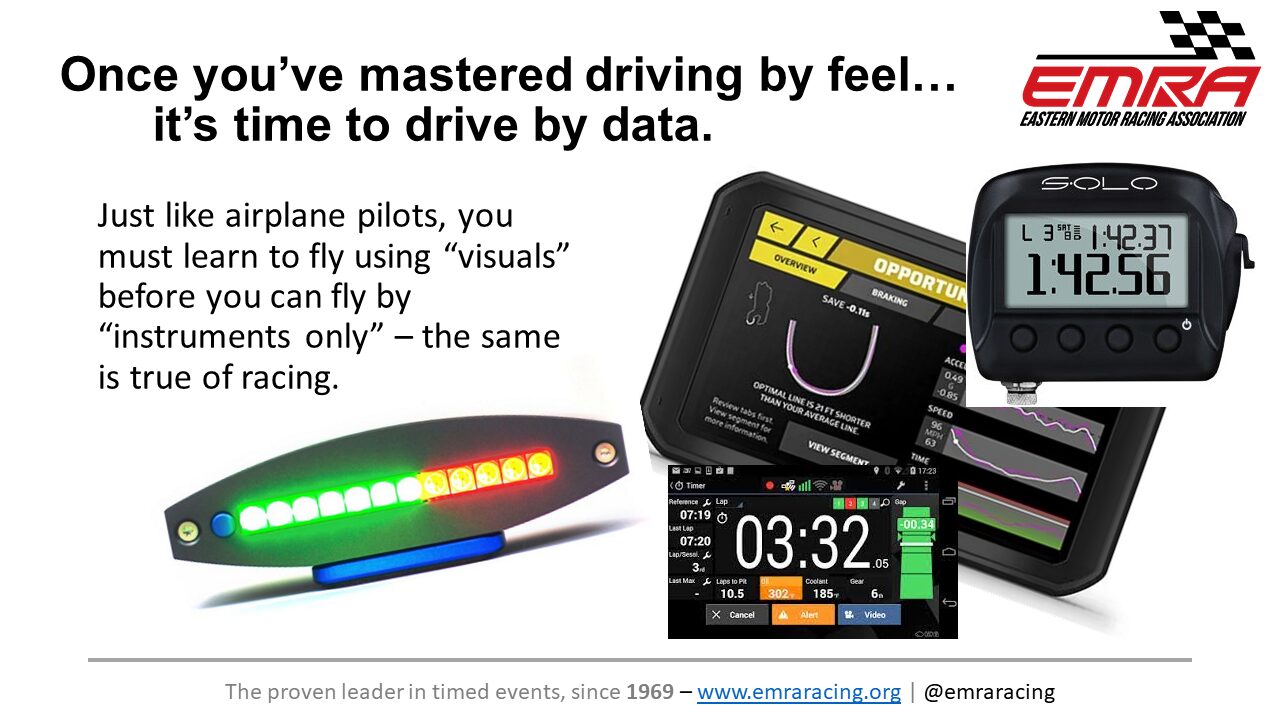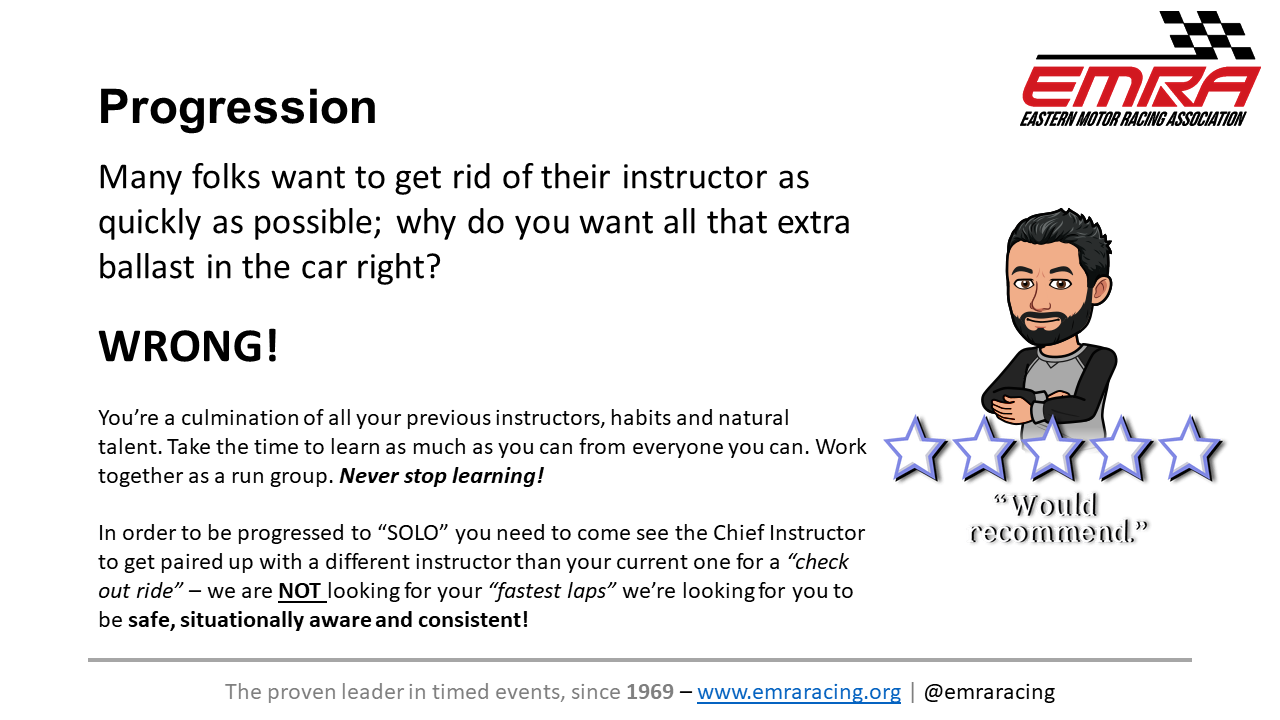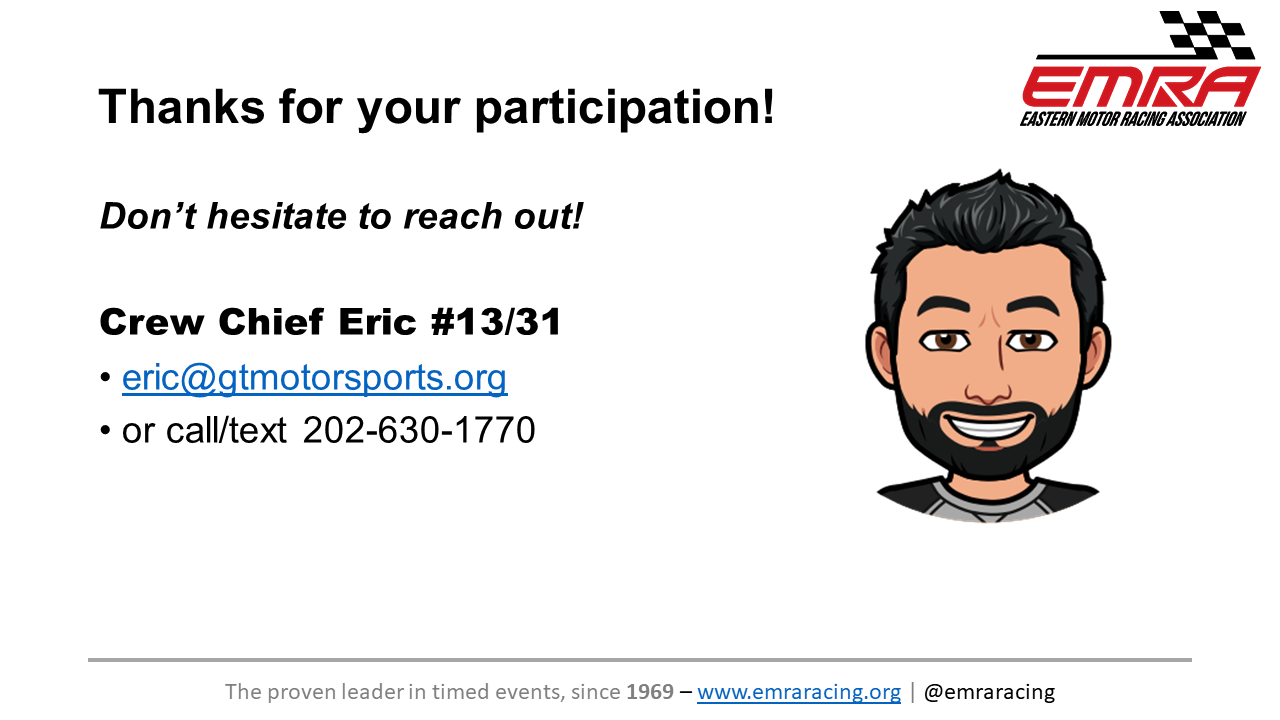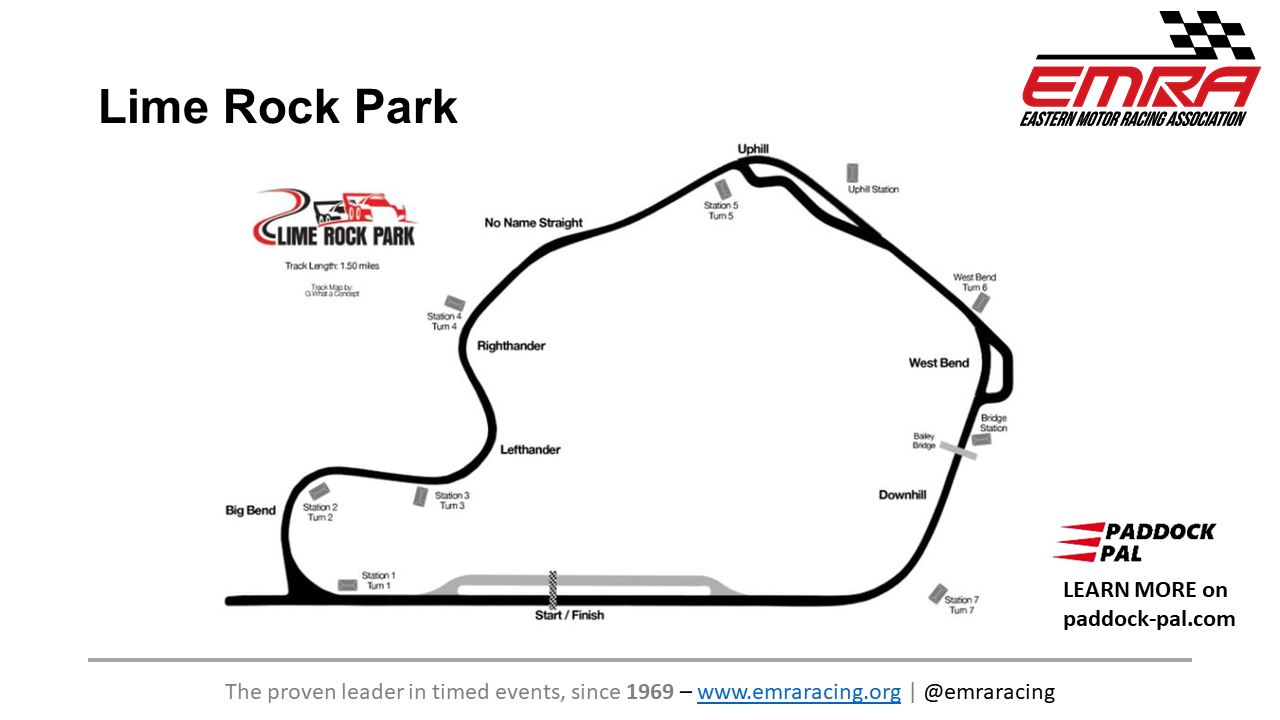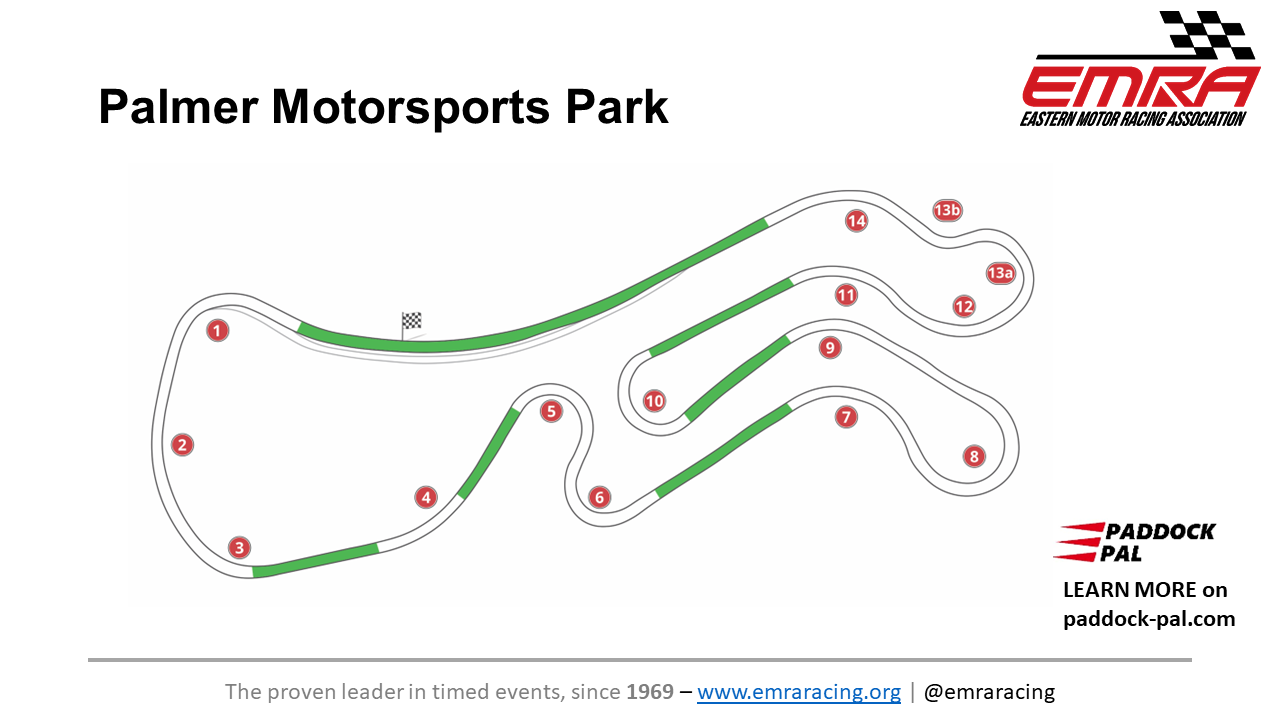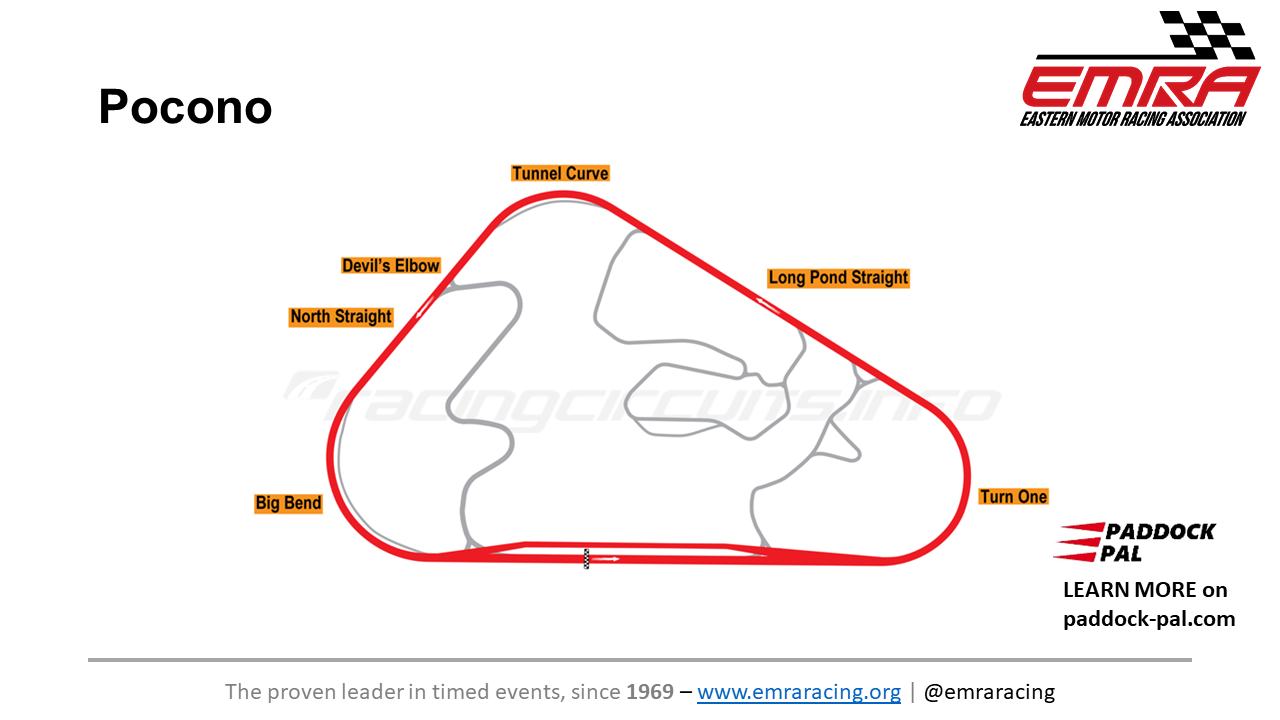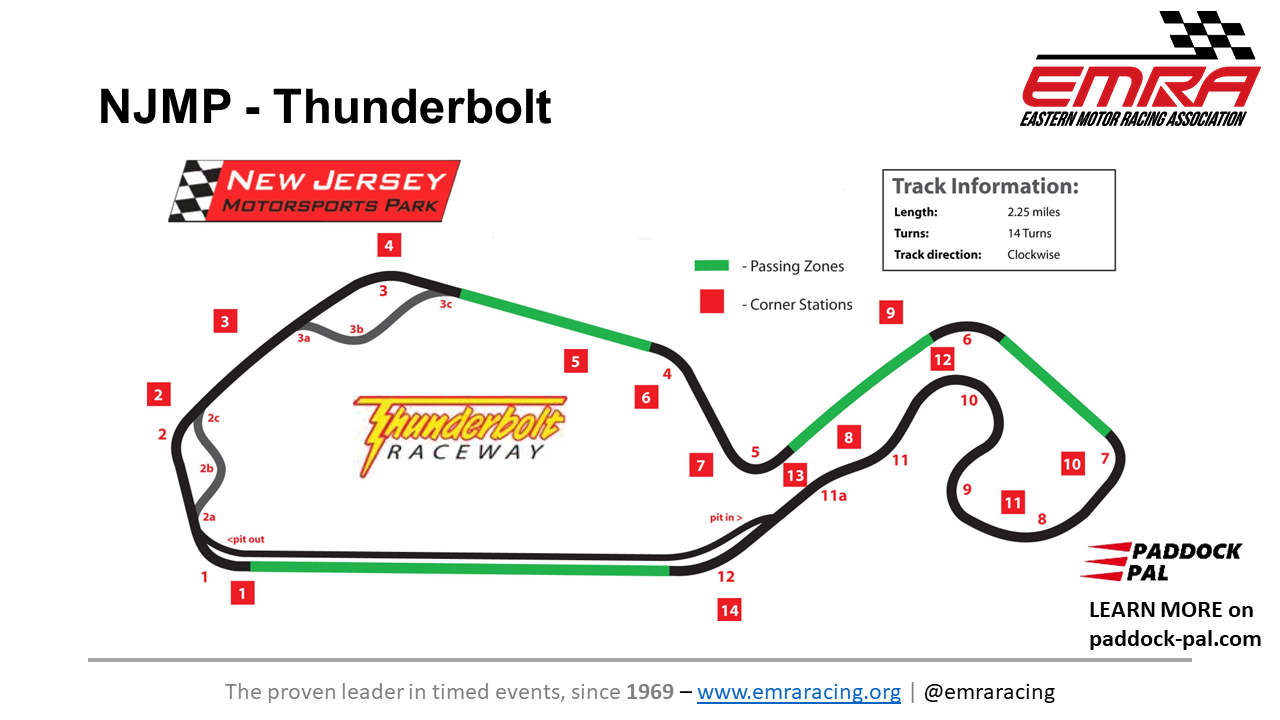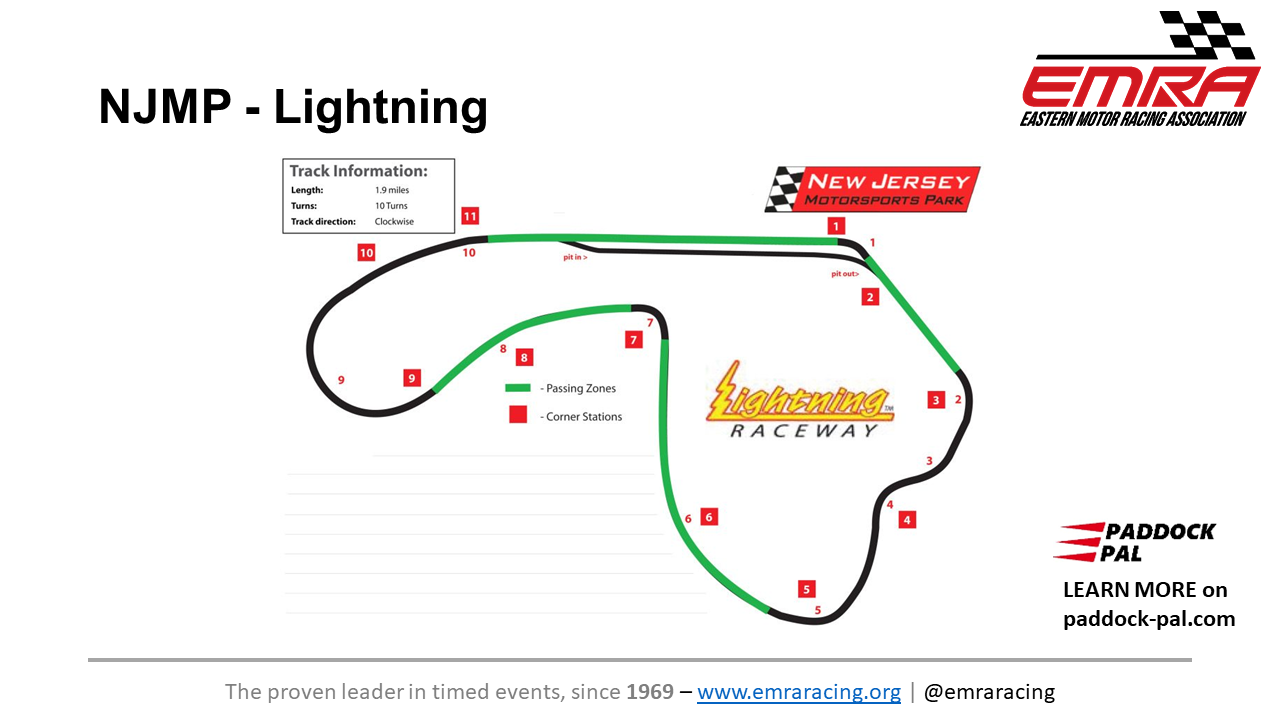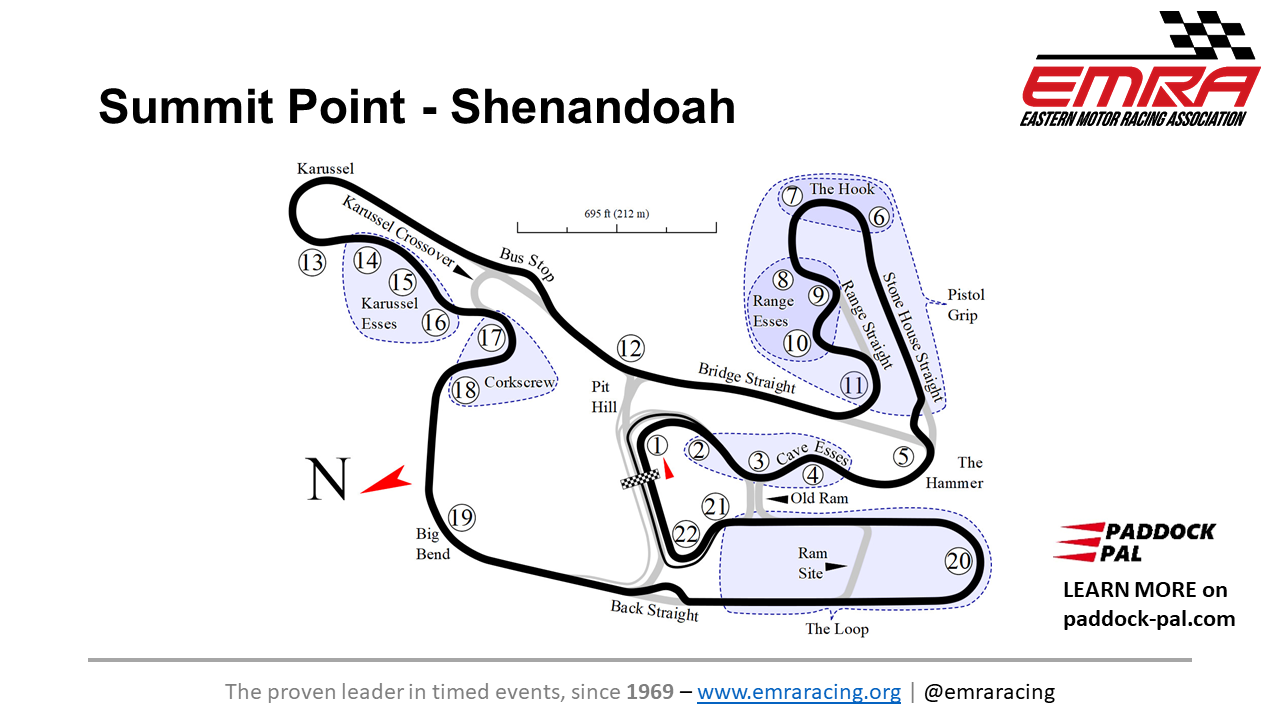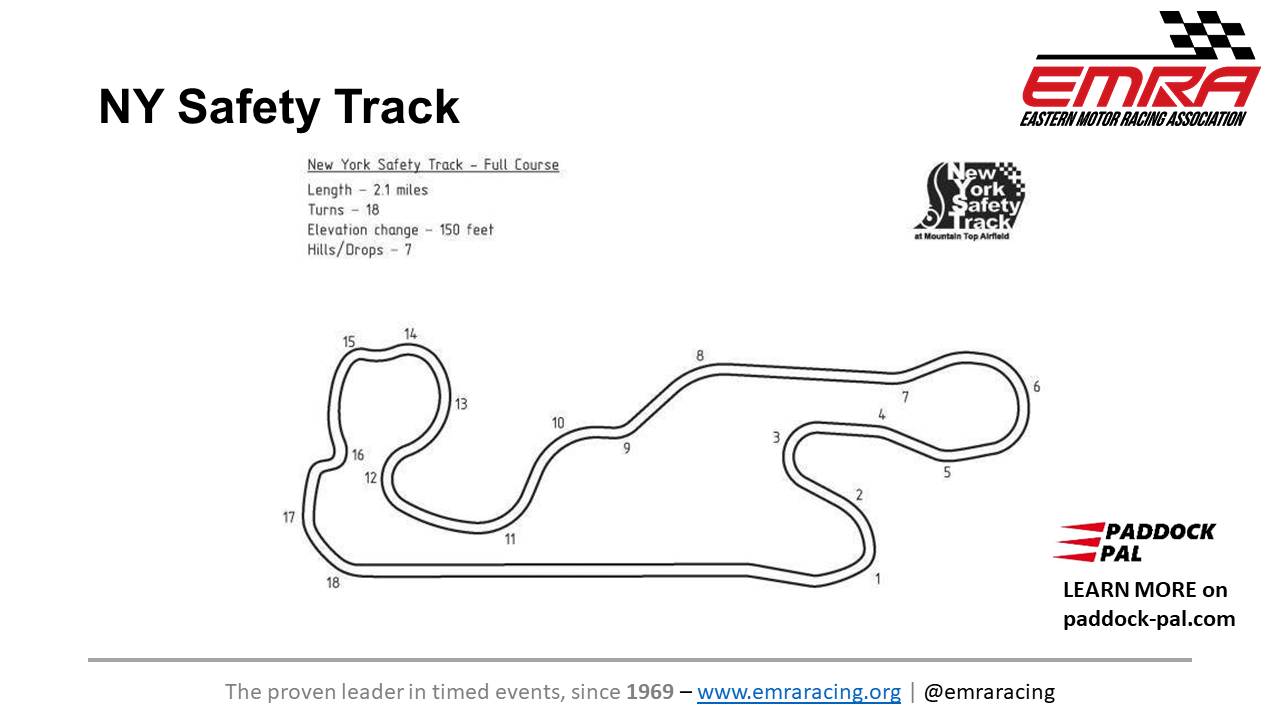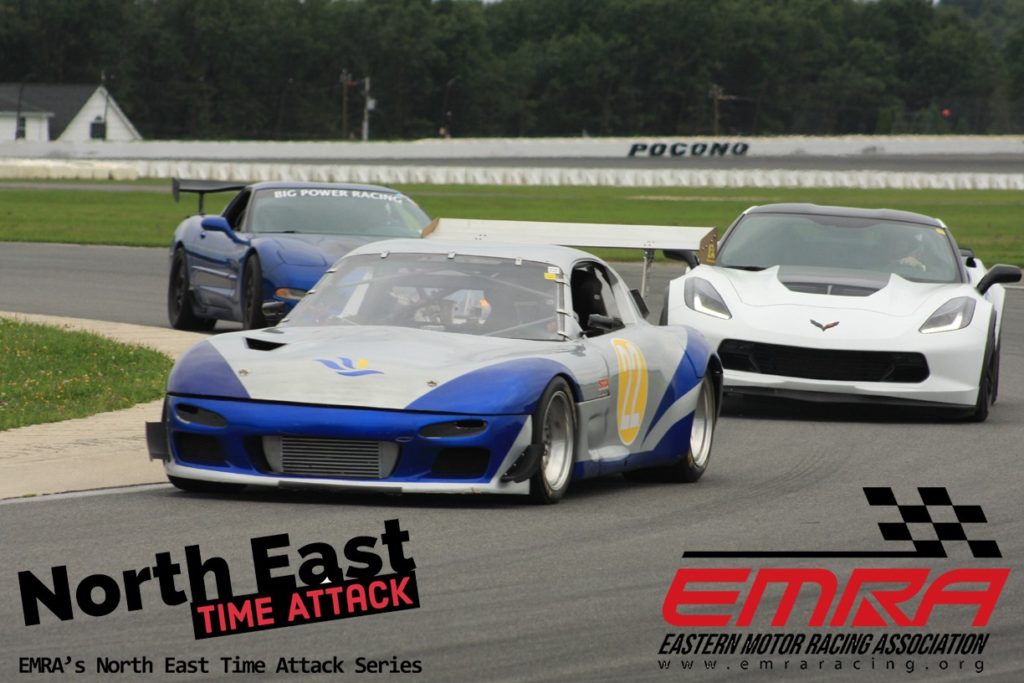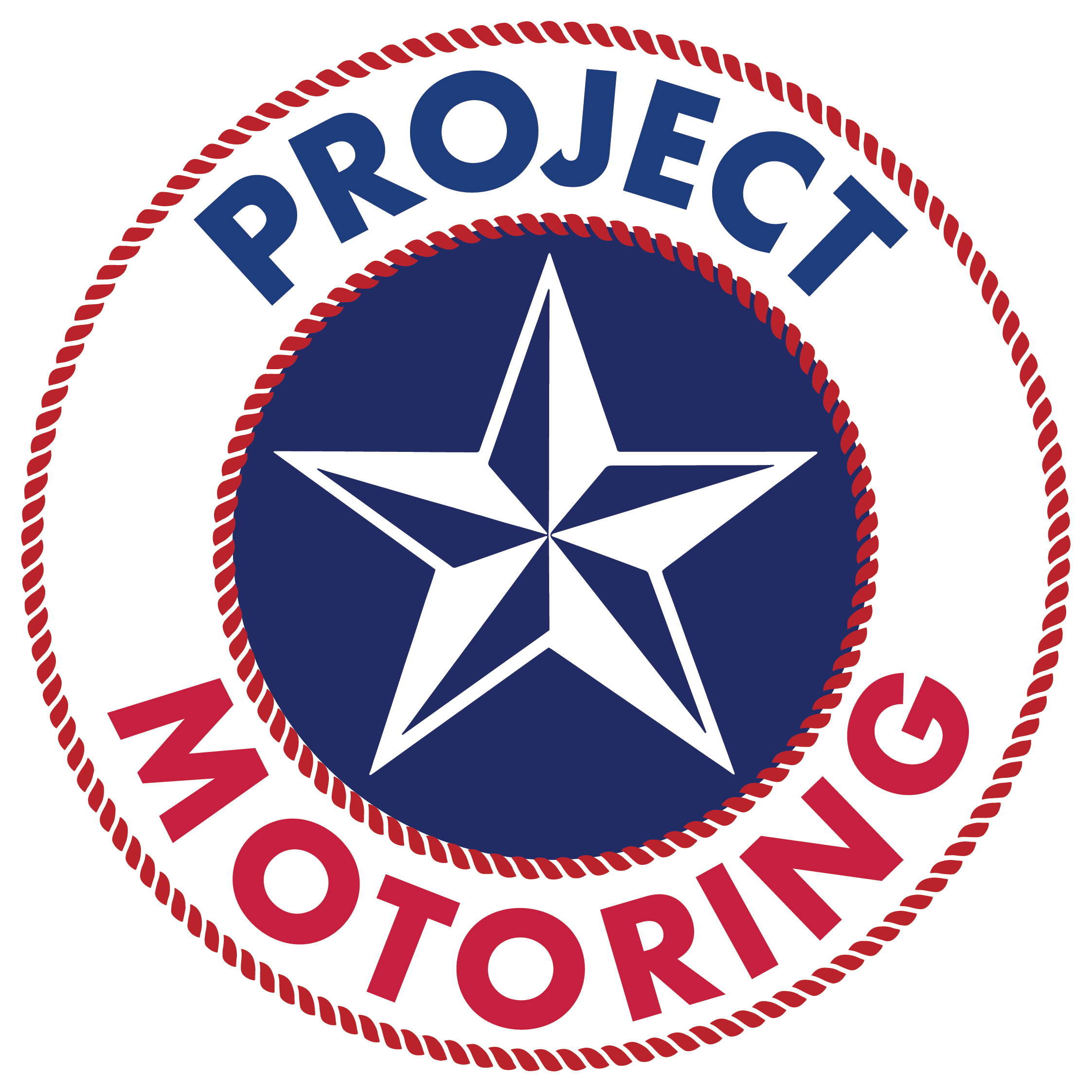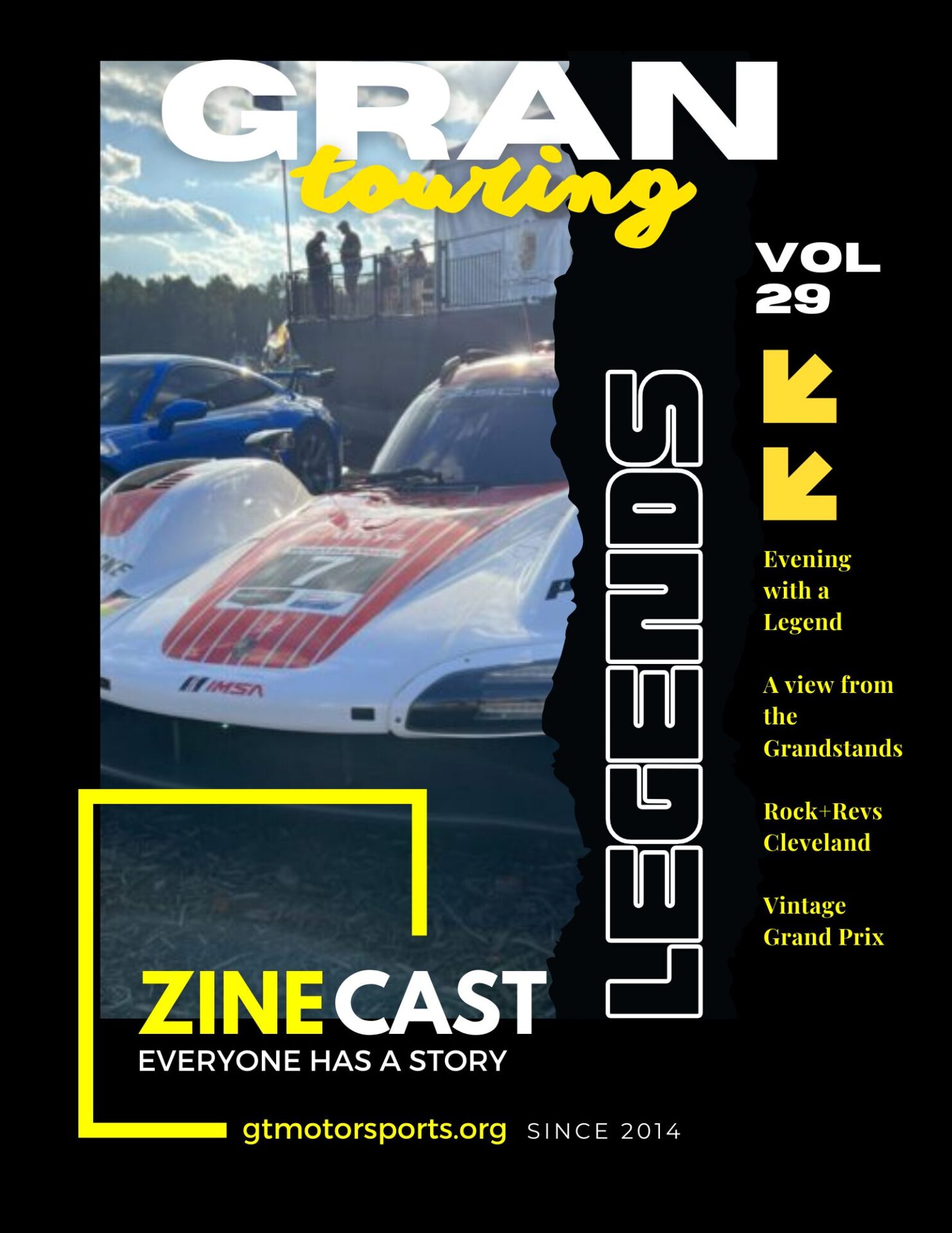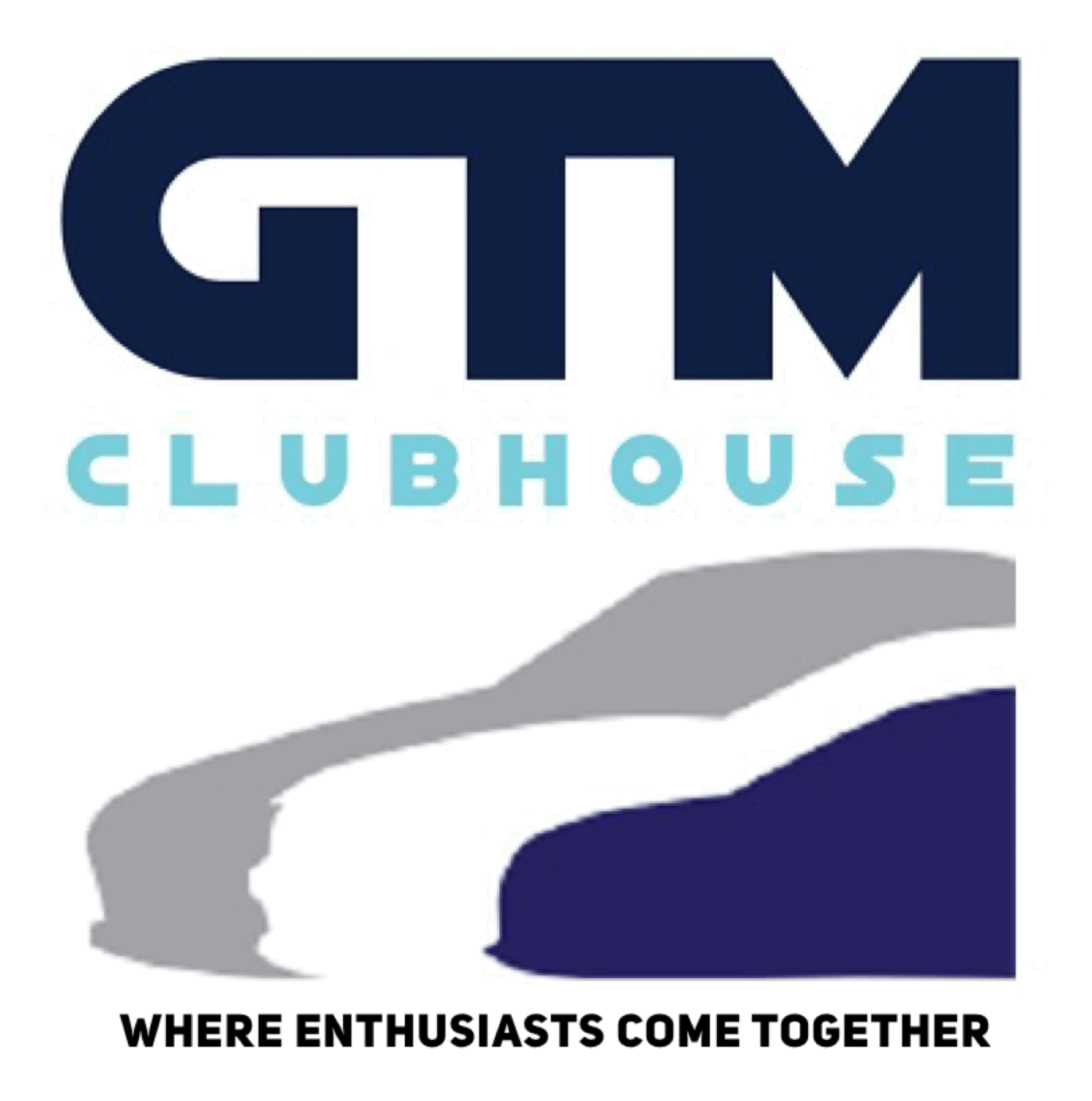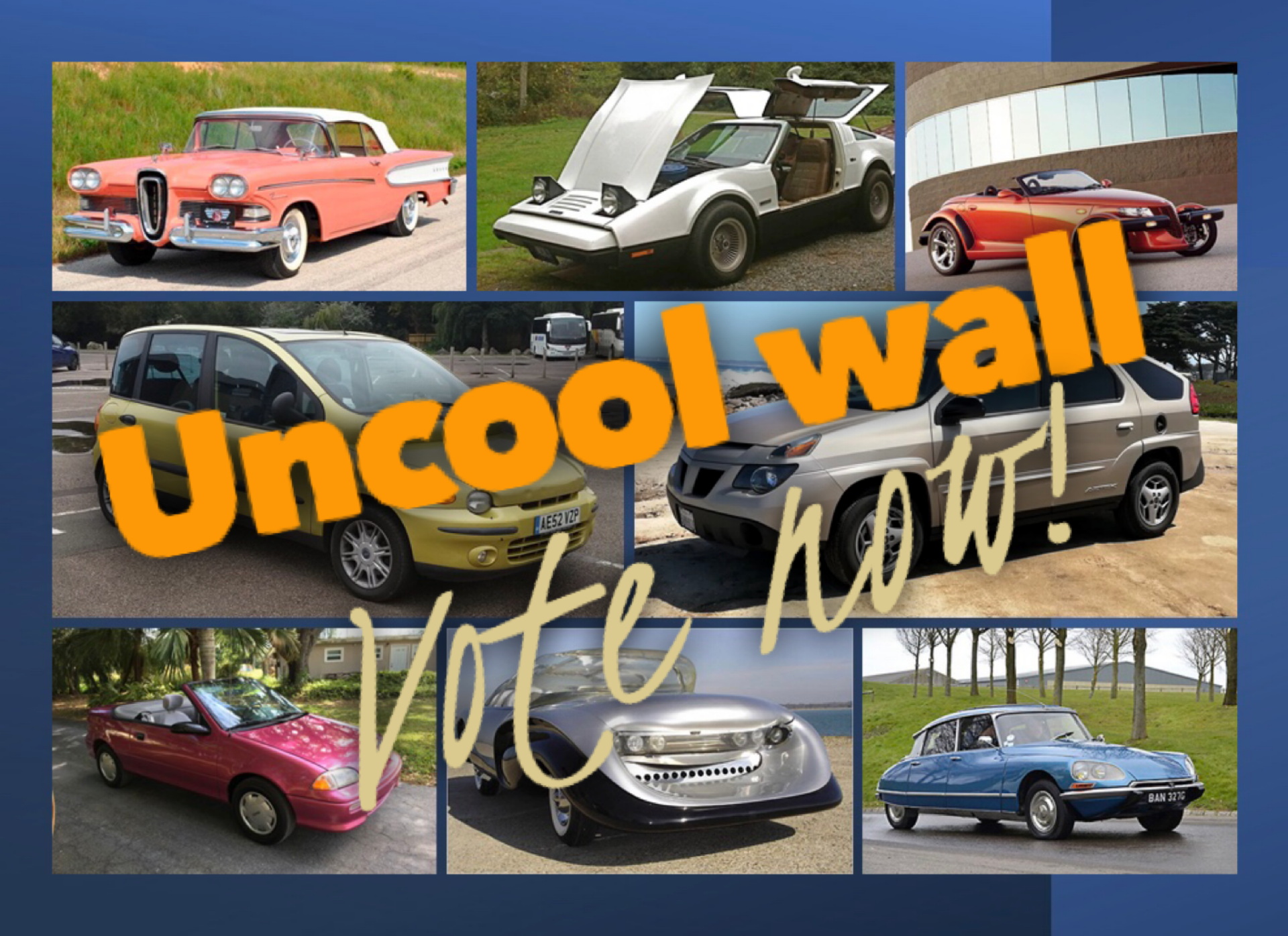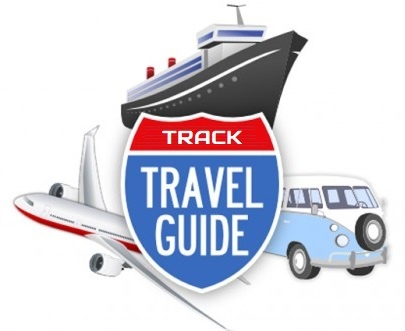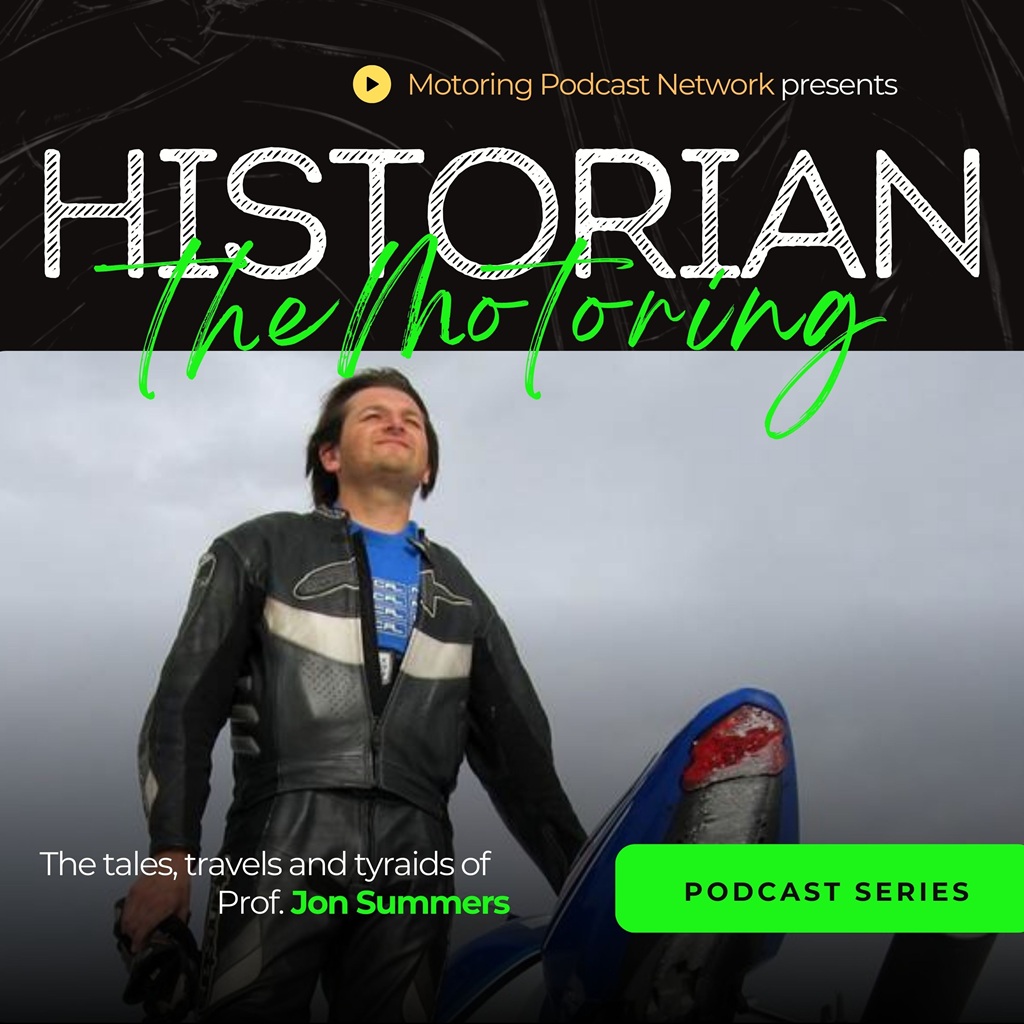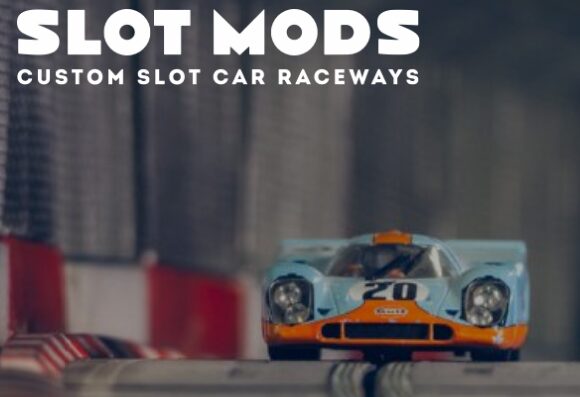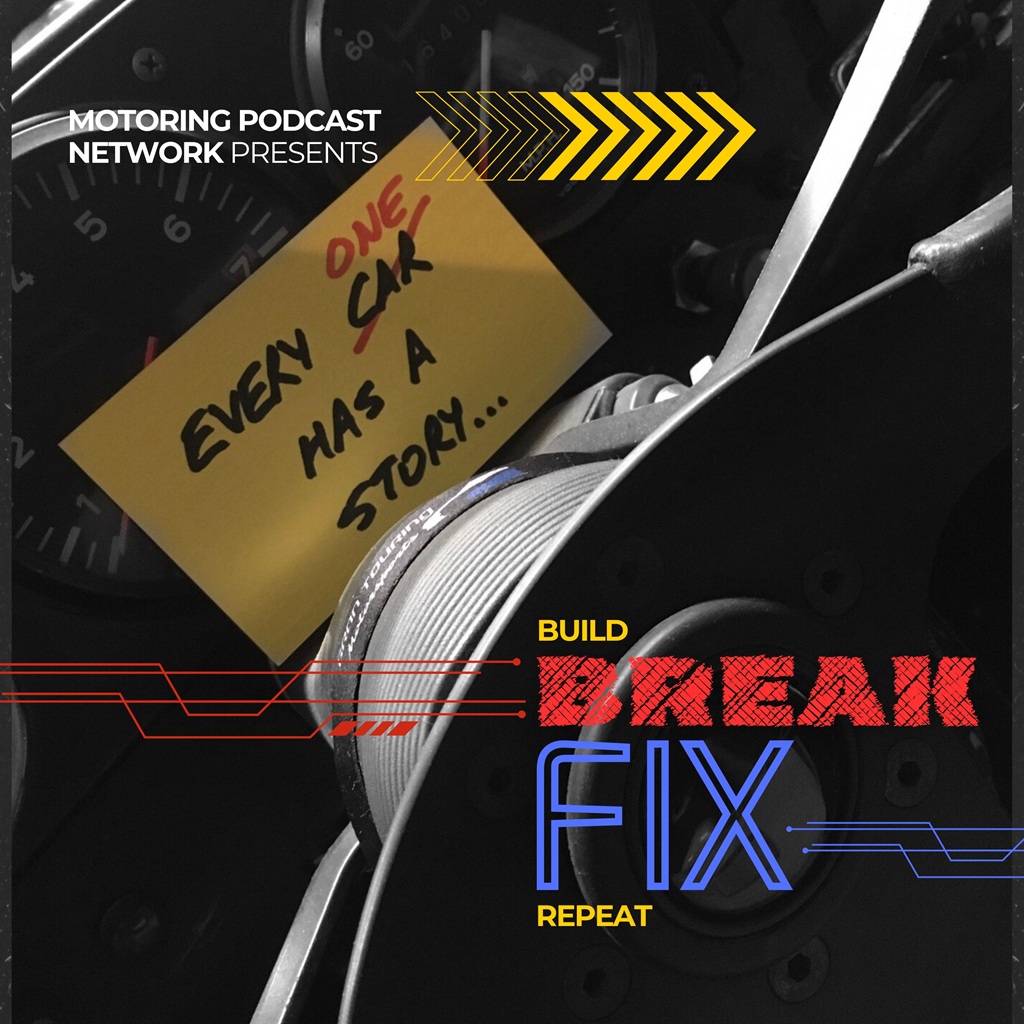At Gran Touring Motorsports, we believe motorsports is more than just speed – it’s about community, learning, and legacy. That ethos was on full display at Pocono Raceway, where EMRA (Eastern Motorsports Racing Association) hosted a high-performance driver’s education (HPDE) event that blended safety, strategy, and storytelling.
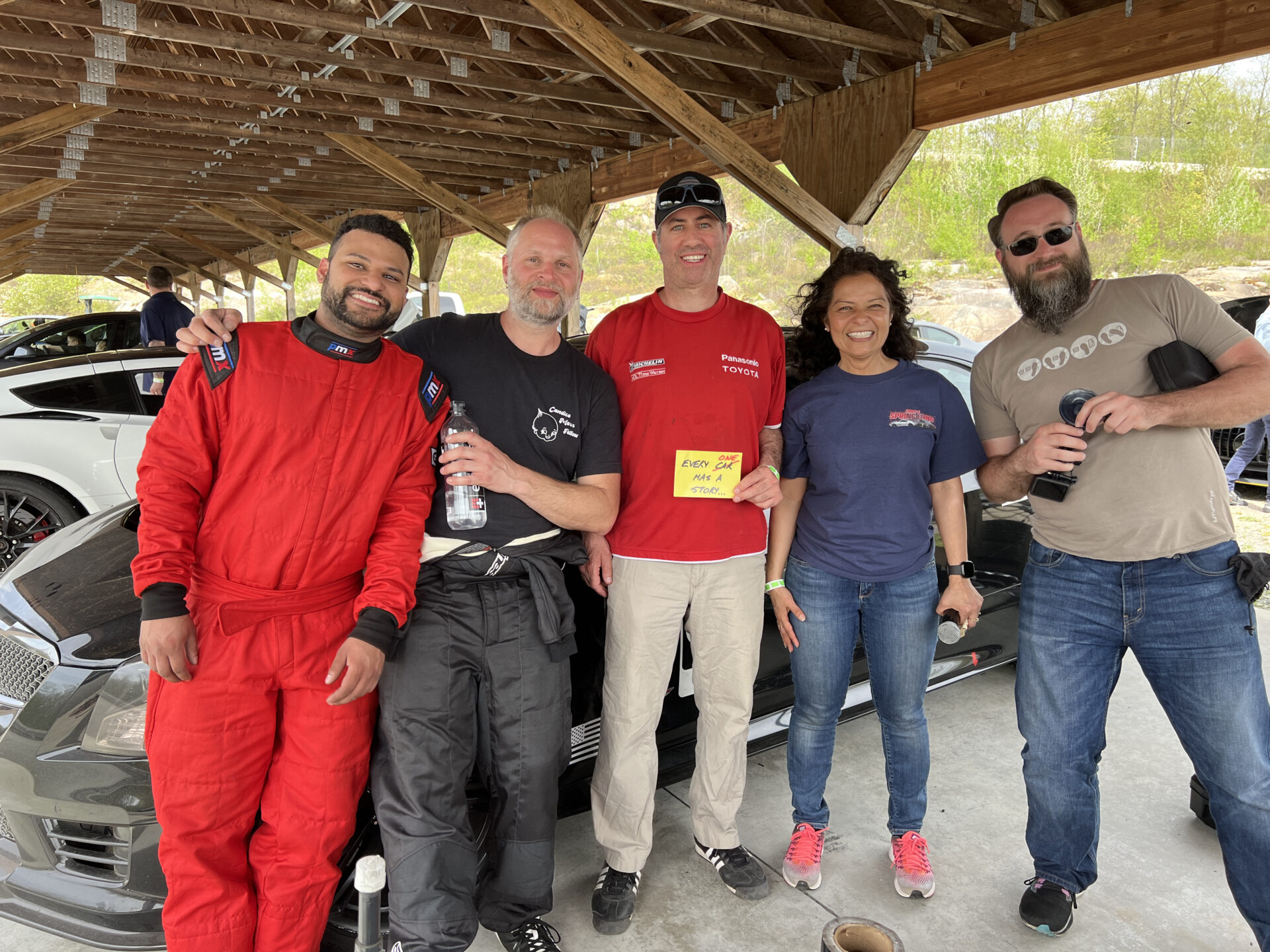
Crew Chief Eric, EMRA’s acting chief instructor and founder of Gran Touring Motorsports, kicked off the day with a candid classroom session. With over a decade of experience and a championship title under his belt, Eric’s approach is refreshingly direct: “I’m not here to coddle you. I’m here to gear you up for racing.”
Tune in everywhere you stream, download or listen!
 |  |  |
The mantra of the day? “When in doubt, pit in.” Whether it’s a strange vibration, a questionable flag, or a gut feeling – don’t hesitate. Pit in. It’s the simplest way to keep yourself and others safe.
Eric emphasized that learning styles vary – some drivers are visual, others auditory, and some thrive on hands-on coaching. EMRA instructors adapt to each student, investing in their growth and tailoring vocabulary to resonate with individual drivers.
- Synopsis
- Video
- Transcript: Classroom
- Highlights
- Learn More
Synopsis
This live episode of Break/Fix shares insights Crew Chief Eric’s years of racing experience. The Eastern Motorsports Racing Association (EMRA), highlighting its competitive racing series and Eric as the chief instructor, offers a comprehensive briefing at Pocono Raceway covering priorities, safety protocols, different learning styles, pit and flag procedures, vehicle dynamics, and advanced driving techniques. The session aims to prepare attendees for racing and improve their driving skills by understanding car setup, braking strategies, trail braking, segmenting tracks, and the importance of practice and consistency. Emphasis is placed on progressing through different racing levels, modding cars responsibly, and making informed decisions on vehicle improvements.
Video
Join us for this 3-part in classroom Racing School presented by Crew Chief Eric of Gran Touring Motorsports.
Follow along with the presentation with these slides! Swipe left or right to view.
Transcript: Classroom
Crew Chief Brad: [00:00:00] Grand Touring Motorsports started as a social group of car enthusiasts, but we’ve expanded into all sorts of motorsports disciplines, and we want to share our stories with you. Years of racing, wrenching, and motorsports experience brings together a top notch collection of knowledge and information through our podcast, Brake Fix.
Crew Chief Eric: A little over 50 years ago, a few local car clubs joined together with the vision of building a better place to race in the Northeast. Since then, the Eastern Motorsports Racing Association, better known as EMRA, has grown to become one of the premier sanctioning bodies on the East Coast. EMRA’s wheel to wheel racing series is designed to deliver close, competitive racing for all cars of all makes and models.
And their goal is to provide top competition without sacrificing any of the enjoyment. EMRA members race hard, And always have fun. Good morning everybody, welcome to Pocono. I’m the chief instructor here at Emron, my name’s Eric. I [00:01:00] have over 10 years of instruction doing trialers, you know, racers, as well as HPDE.
I was the 2018 ST5 champion here at uh,
Audience Q&A: Emron.
Crew Chief Eric: I founded Grand Touring Motorsports, I run a podcast, a bunch of other kind of fun stuff. My contact information is there, my card is here, if you want to get a hold of me after the fact. Go ahead and talk about what our priorities are for today. So first and foremost, the difference that you’ll get in the classroom session here at Amron versus any other club that you go to is that we are gearing you up for racing.
I am not here to coddle you, I’m not here to teach you how to drive, you got here safely so we’re going to continue with that idea of safety is number one priority, but the end goal here is to get you to progress through the system and become a time trial, which is very different than a club racer or just somebody that does high performance driver’s education.
Thank you. Safety is number one, number two, I want you to have fun, and number three, you’ll learn something as a result of that, and finally, going faster. Going faster is always the last thing, and we’ll talk about that in the situations of where you have an instructor in the [00:02:00] car. The methodology that we use, going fast, is always the last thing in the equation, and it will come naturally.
You will get progressively faster. I have to go back over some of the things that are covered in the safety briefing. We’re going to talk about your setup, we’re going to talk about how to beat the clock, and we’re also going to talk about So we’re going to talk about advancement and what advancement is and what it’s like.
Safety first, there are all different kinds of students. We all learn in different ways. Coaches like myself and like Brad and others that are here, we are trained to adapt to who you are and how you learn. Some of you guys are auditory, some of you are visual, some of you are book people, whatever it might be.
Let us know. You’re not absorbing the information as it’s being given to you from an instructor. Safety first. We have to adjust to that. We’re going to learn. We’re going to ask you questions. We want you to talk to us. There’s going to be debrief sessions. We’re going to be working with you. We’re investing in you as a driver.
So it’s important that we understand that. We also need to learn your vocabulary. Certain words are going to be used and we’re going to go over that as well. We’re going to adapt throughout the day [00:03:00] as we work with you. My number one rule, this is to shorten the entire safety briefing from this morning, is when in doubt, pit in.
Okay, they talked about the black flag and, you know, losing laps and all this kind of thing. If you see a black flag, the natural reaction for anybody who’s ever seen one is, well, was that for me? Was that for the guy in front of me? And then you’re going around another lap going, am I going to see another black flag?
Again, there’s that doubt suddenly in your mind, just hit it. If something’s vibrating on the car, something doesn’t feel right, hit in. We’ll go until it breaks, and then I know it’s broken. But again, if there’s that as a student, as a beginner, if there’s doubt, come in. It’s just easier for everybody, and it keeps the flow of the event moving.
Number two rule, I guess, is always remember to take a safe approach. to learning anything at the track, right? Especially if this is your first time doing this. When you’re driving on the street, I hate to say, anybody can go fast in a straight line by pressing down on the skinny pedal. It becomes really real at a [00:04:00] racetrack when you go into a turn at 90 miles an hour and go, how do I get over there?
It’s not the same as when you’re on the highway. It’s just a totally different animal here. So safety first. Take a safe approach. Build up to the speed. You guys saw the flag briefing this morning. I’d like to cover it again. I summarize this. Just know your colors. The basics are simple. Red, stop. Green, go.
Checkered, it’s over. It’s all the nuances of the other flags that are really, really important. Different organizations do the flags a little differently. Sometimes you’ll see variations in the blue flag. People go, what does the yellow stripe mean versus the orange? I’ve seen a red. They’re all the same thing.
NASCAR uses red, we use orange. PCA uses yellow as a stripe on the blue flag. But it all means, hey, there’s a faster guy behind you. You’re not paying attention, let him pop. All the rest of these, there’s really nuances in the yellow flags and all that kind of thing. We’re going to talk that. So my friends like to summarize what the flags mean, green is send it, you know, somebody else is sending it too hard, you’re last chance to send it, all these kinds of content.[00:05:00]
But I really want to address some important use cases that they don’t talk about in the safety briefings with respect to flags. This, the idea here, is that it gets you thinking. I’m going to ask, and somebody volunteer an answer. After a red flag has been shown, which color should be thrown next? You guys know the answer to that?
Black flag. Black flag. Exactly. Why is that? Does anybody know? The reason is, in a full stop condition, as he said this morning, you stop by the closest flagger station. So they can see you, they can take accountability of everything that’s going on on the track. The next logical conclusion is that they’re going to bring you in.
They red flagged that session because there was either a wreck or debris or something they needed to take care of. So that should already be in your mind, a doubt. Red flag. Oh, I’m not sure what’s happening next. I’m going to come in. When in doubt, pit in. When the checkered flag is thrown, you should reduce your speed to 55 miles an hour.
True or false? Show of hands for false? The answer is false. Right? You can continue at [00:06:00] your pace. Obviously you’re going to slow down as you pit in and come into pit lane. But there are some people that will drop anchor on track when they see the checkered flag. No. There’s a lot of folks out there, especially if you’re running in mixed group or you just got advanced.
They want to come in, they want to check their tire pressures, they want to check their temperatures. The car needs to be at a certain temperature to do all that kind of stuff. So be respectful of that. Just keep the pace. You can start to back off, but you don’t need to just drop down to 45, you know, kind of put your way into the track.
When you see a standing yellow versus a waving yellow, does anybody know the difference between those two? It’s actually really important. Standing yellow, you see a flagger just holding a yellow flag. It means that there is a precaution condition still existing in that particular apartment. It’s not active, it’s being taken care of.
So it’s a reminder, hey there’s a dead groundhog here, there’s something going on here, there’s a car that’s off. If the flags are waving, it means a currently active caution condition. Like somebody just went off, they’re trying to get your attention because this is new cautionary activity. [00:07:00] So that’s the big difference between standing and waving.
Double versus single, things like that, that’s all based on the flag routines and how they like to do things. Some will use double yellows instead of waving yellows. Those are just nuances, but understand standing versus waving. There’s an importance factor there, and that translates to black flags as well.
A pointed or standing black is very different than a waving black flag. You guys need to come in, when in doubt, pin it. Which flags indicate a caution situation? Yellow. Do you guys know? Yellow’s one of them. It’s
Audience Q&A: the obvious one. Black. Red. Red, no. Oh.
Crew Chief Eric: The other one is It starts with a W, the white flag. All of those are cautionary flags, right?
Say you’re in an organization doing hot pulls like NASA, you’ve got emergency vehicles out on track, you need to be aware that’s a caution situation when you see a white flag as well. After two laps, the debris flag was shown, the hazard was cleared, true or false? [00:08:00] False. Yes, the answer is exactly false.
You need to be constantly aware of what’s going on on the track. You’ll hear a lot, especially from instructors, get your eyes up, get your eyes up, you should actually be scanning the asphalt and things in the distance because that gopher or that puddle of oil, or maybe we use some oil dry, which is basically kitty litter on the track, still there.
The conditions of the track surface have changed. In bad weather, it’s the same thing, drying versus wet and all of those situations in between. You have to be constantly. Scanning up and down, and then thinking about the conditions of the track surface. So just because the debris flag got taken away doesn’t mean that the asphalt is completely clear.
You need to gauge that for yourself. There’s been plenty of people that have been surprised, but I don’t know, my car stepped out suddenly in that turn. Well, there was a debris flag that got taken away a couple laps ago, so maybe there’s something still there which flags indicate that you should return to the pit black flags and B checkers and B [00:09:00] blue flag.
It’s an assumed, oh, the red flag, right, because the black flag comes next. In the case of an accident, and you don’t see a flag at a station, you should assume the following color is present. Red. It’s going to be immediately a yellow, followed by a black. So if you see a car go off, and an accident happens in front of you, pit in.
Because the next flag out is going to be a black or a red. Caution’s going to be thrown, that’s obvious. But, again, if something happens and the flaggers haven’t reported, you see it, don’t just keep going. Just come in. Because you know what happens next. Again, this is thinking ahead. Again, when in doubt, pit in.
This one doesn’t get covered often. They talked about putting your fist out the window, and we’re going to go over this again in a minute. The pit in signal. True or false, is an implied blue flag, is an implied pass, yes or no? True. False. True. The answer is true. If somebody gives you a pin in signal, in this case we’re gonna be on the left, but generally on the [00:10:00] right, and they’re pulling off, that’s your indication, that’s a passing signal, you can go around them with caution, just be careful, make sure they don’t do anything weird.
But you don’t have to sit behind them. I’ve seen plenty of people sit behind somebody that’s saying that they’re pitting in. You can go right around them. That’s an implied pass. It’s very important. Especially if you’re out there, you’re competing, you’re in the enduro or something, somebody’s got to come in.
Why sacrifice that lap? You can go right around them and keep going. That is allowed. If you see a black flag and you’re not sure what it’s for, what should you do? I want to hear you all say it.
Audience Q&A: Hit it in. Hit it in.
Crew Chief Eric: There we go. I got to cover this too. Never get out of your car unless you see fire or heavy smoke, then you can bail immediately, right?
Head to the closest wall to the closest corner station, whatever it is, get away from the vehicle as fast as you can. There are other organizations that actually do exit drills. You have to do within a certain amount of time, get unstrapped, all this kind of stuff. Don’t try to be a firefighter. Your car’s already on fire and don’t forget [00:11:00] there are things under the hood that act as catalysts.
Opening the hood is one of the worst things you can do if there is a fire. It’s just you’re adding oxygen to it and you’re making it worse. There are tracks out there though, personally going through this situation myself, where they’re like, Here’s an extinguisher, you can take care of it. And I’m like, I’m not a volunteer firefighter, I’m sorry.
Remember, at that point, what flag will suddenly become active? Especially if there’s a fire condition, right? Yellow flags, everybody’s gonna slow down. They’re gonna start black flagging, especially if the car’s on fire. They need to take care of you right away. Again, for any other issues, mechanical, you hit the wall, whatever.
Stay in your car, keep your helmet on. A lot of people immediately take their helmet on. The reason we tell you to keep your helmet on is because Say in worst case scenario, somebody’s following you, you go off and they go off behind you or they suddenly target fixate on you and happen to go off. Maybe there’s oil in that spot and they hit you and they hit you and you’re in your car without your helmet on, you do the math.
Stay with all [00:12:00] your safety gear and stay in the car. You are better protected there. Unless there’s a fire. There’s a lot of words that are going to be used if you have an instructor in the car. I highlighted most of them here and we’ll talk about them as we go through. A lot of us refer to this as just technical jargon.
Many of us get overloaded with all these terms. But, Break, wait, turn in, turn out, unwind, open the wheel, means to open the wheel up, right, go back to straight, go, aim, means to fixate on something, and then both feet in, especially if you’re in a spin condition. The rest of these words are all interchangeable.
But what I talked about earlier, about being adaptable, especially with a coach in the car, is that we’re going to learn the words that you use. So maybe I’m using aim, and you’re like, focus. Alright, well I’m going to change to focus, because that resonates with you. That’s the word you’ve told me that your brain is processing.
So we’re going to work with you on this. But there are these basic, you know, eight or ten terms, and you’re going to hear that. Instructors are super concise, right? They’re, in the beginning, repetitive on every corner. [00:13:00] Do this, break here, turn now, gasp. If you’re having a conversation in the car, you’re not learning anything, right?
It should be very direct, especially in the beginning, as somebody who’s doing this for the first time, is what you need to do. We need to get you acclimated and oriented to the track as quickly as possible. So it means that you’re going to be in a group of mixed Skill levels. You’re going to have people that have been in red because the green students run with the red at the same time.
They’re out there solo, and they’re mixed in. So we want the communication that we have, like we do with the track, right? Flags are our way of communicating, or the track communicating with us, the way we communicate to each other. We don’t have comms in the car like they do with World Challenge or IMSA.
You know, we can radio back and forth. The only thing we have are hand signals. And the hand signals need to be clear, they need to be early, and they need to be very direct. They cannot be ambiguous in any way. So I like to cover what a passing signal looks like. When you’re passing on the left hand side, you want somebody to go around you on that side of the car, the left side of the car.
It’s demonstrative. It’s big movements. [00:14:00] 1. 5 per car. Go around me. If you want somebody to tuck inside of you on the right side of the car, up and over the roof. Get that arm under. None of these, like, T Rex arms. You see this all the time with the Miata guys. No offense. You have the smallest car in the world, and you can’t get your arm out the window.
I don’t get it. Get them up there. Make it known that you want these people to go around you. Just be clear and be direct. No confusion. And it’s 1. 5 per vehicle. So if you have two cars behind you, 1. 5. And then the next one. Now there’s little two fingers, I can’t see that. The other thing is, we tell people, not only for your own safety to wear gloves, get yourself gloves, get high vis colors, right?
Because if you do this longer term, especially as you move up, a bright orange, a bright yellow is a lot easier to see, and I know I’m a hypocrite because I wear black all the time, but seeing that orange come up over the roof, boom, there’s my passing signal. You are not allowed to pass until somebody gives you a point by it.
So what does that mean? There’s a negotiation there between you and the other car, whether [00:15:00] you’re the chasing car or you’re the car that’s being pursued. Waving in the mirror is what everybody says, but it’s nuanced as well. If you’re chasing somebody, And they say, they tap on the mirror and say, Hey, I see you there signaling behind say, yeah, it’s over.
Good. I’ll give you a point by soon. You can’t wave in the mirror either. You have to wait under it to say, Hey, I got you. Because if you have somebody behind you, then they’re going, Hey, he’s going to give me a pass. And then it gets all confusing and people, you know, again, miscommunication need to minimize that.
So all you have in the car are your two arms. I know it’s very busy, especially in a short course like we have today. Left arm is always commands. Do this. Pass me here. Pass me there. Inside the car is signals back and forth. You’re communicating with the other car saying, no, I just want to follow you right now.
Or, yeah, I got you. I see you’re back there. I’m going to set this up as soon as I can. If you guys come to that agreement, that’s what we try to teach you this stuff, common language amongst all of you, it becomes very easy. Passing is fluid. It’s early. It can be done [00:16:00] seamlessly. And we’ll talk about doing it early and passing strategy and things like that.
As I said before, pit in, fist out the window, 90 degree elbow. I mean, kart racers do this and they don’t have windows, right? I’m pitting in. It’s a universal signal for I’ve got to come in, you know, whether you have an issue or not. But again, it’s an implied pass when that pit signal is out the window.
Bonus question, which way are we going? I can’t tell you how many times I’ve seen this before. I guess a helicopter is passing me, right? This is not a point by. It doesn’t mean anything to anybody. It’s either out or up and over, right? You gotta get that arm up and over the roof. Alright, still talking about safety and talking about driving technique, especially if you’re out there by yourself.
A lot of people talk about the ergonomics of seating position. I’m not here to tell you how to put your seat. There’s got to be X amount of inches from the steering wheel. You know, I don’t want to see anybody like lean back, but there’s three different hand positions you can use when you’re driving a car out on track, especially when you’re competing.
You can go with the classic 10 and 2. You can do 9 and 3, and then what we [00:17:00] call low grip or cart style, which is 7 and 4. A lot of guys are comfortable with that because they don’t have to put in a lot of movement. The idea is that you still have the same range of motion when you’re working the steering wheel at that point.
No one handed, no resting on the shifter, none of that kind of stuff. Put your hands in position. Because remember, this isn’t like driving on the street. And when you go to a more complicated track, let’s say like Shenandoah Circuit, right, that Emra goes to, 17 turns in 2 miles. You never get a break. So you need to know exactly where your hands are because you’re shuffling all the way through that track.
Leads us into a segue about fixed steering versus shuffle steering. So a lot of guys, when they first get out there, their first time, they’re anxious, they’re nervous. I’ve seen some guys just vein out, they’re gripping the steering wheel like they’re at the gym. It’s like, chill out, relax, find a comfortable arm position in any one of those three positions, and just work with the car, right?
Don’t overstress. But, be mindful, every car is different. You need to learn what the kind of steering ratio is. Don’t forget that. I hate to say the term, like trucks, and others are like Mini Coopers, where they’re like go karts, right? [00:18:00] So you get into this debate, and some people, it’s almost a religion, they’re like, never move your hands from the steering wheel, just pick your position.
And then when they end up in, I hate to say it, a Code Brown moment, they’re doing one of these numbers, because their steering ratio is so big, they can’t turn anymore. And they’re like, well, the car won’t go! Well that then gets into a debate about shuffle steering. There’s the classic shuffle steering, where you’re doing all this movement, and it’s not efficient.
for driving here on the track, and you see a lot of autocrossers shuffle steer. What I try to propose to people is a combination of the two. It’s a pre placement or pre positioning of your hand, and you bring it to the point where you want to execute that turn. So your steering wheel may be turned down here, but your hand is right where it needs to be at like 10 and 3 and whatever, so you’re doing like a slight shuffle steer.
You’ll learn all this kind of stuff, and your instructors will work with you on like what’s the best approach, learning about your car, you know, things like that. But hand placement and how you use it. You’re going to realize how short this is and [00:19:00] how busy it is at the same time that you’re going to need to find something that gives you a nice rhythm to work with the car through these chicanes as you’re, as you’re getting through the program.
And again, everybody’s got their style. I’m not here to critique, but your instructor is going to work with you on what’s safe for track use versus driving on the street and all that kind of stuff. Other things I want to address with respect to shifting. Show of hands who’s in a manual transmission car.
Okay, good amount of you. So this is really important for you guys. It doesn’t really get talked about a lot. Because again, the assumption is you know how to drive. But there’s a lot of mistakes that have been made over the years with respect to, You know, you hear a guy, I blew up my transmission, or I money shifted, and you know, I flipped the car over.
You hear all these ridiculous stories, these big fish stories, but they’re actually true. And some of it comes from really, really simple things that we have forgotten from driving on the street for so many years. We all sort of learn how to overhand shift, right? Kind of just meatball the shifter and go through the gears.
What ends up happening is, this is a [00:20:00] physiological thing. When we shift that way, the natural tendency for our elbow is to come to our hip. It’s just how our body is designed. So you hear the guy say, I’m going to shift it. I grab second gear instead of fourth, coming out of fifth gear, going into that turn.
Why? Because you grabbed it like this, and pulled it towards yourself, and yanked second gear, and that was the end of that. So, what we’ve done is we’ve come up with a couple alternatives, and you can try these, and practice them on the street. If you’re not comfortable doing it here at the track, you can practice in the paddock, whatever have you.
The overhand shifting method, kind of still continue that, but what we recommend is moving to what is called palming. So you’re kind of slapping 3rd and 4th by using your palm to move the gear selector through 3rd, that way. So that way you’re not grabbing it and pulling it towards yourself. There’s also the concept of underhand shifting, which is what I do, which physically forces the shifter away from my body.
I’m pushing it away, and I’m pulling it back this way, especially when I grab fourth and sixth gears. There’s no way for me [00:21:00] to put it in second gear because I can’t physically do this without becoming a T Rex. So shifters. And we’ll talk more about feet position as we go through advanced driving techniques later.
Important reminders! They probably covered this already. If they didn’t, I’ll remind you again. No loose art in the car. If you have something in the windshield, like a suction cup for a GoPro or whatever, a lot of tracks require you to tether it. Tethering is just put a zip tie on it somewhere on a bench or something like that.
Because if that suddenly comes loose with your windows down, it flies out the window, is now a projectile, and we got a debris flag. And potentially meatball fly if it busts somebody’s windshield. So anything like that, make sure it’s secured in the car. And I know the ram mounts are awesome, but they, on a hot day with the right angle, they will pop loose too.
And you see GoPros just flying out the car or bouncing around inside your car. You create another hazard at that point. Clean and clear windshield. Again, your seating position is up to you and your belts. Make sure that everything is tight. If [00:22:00] you have a three point system and not like harnesses, like some of us have, consider getting yourself a CG lock.
Especially if you find yourself kind of loose in the car and fighting in the car, CG locks are great to keep the belts tight. Sometimes guys have them here where you can buy them from like safety providers and there’s that very cheap upgrade for the car and for your safety too. Something else they didn’t talk about and it’s not going to exist on this track configuration is the blend line.
Does anybody know what the blend line is? You do. You got all the answers.
Audience Q&A: It’s when you’re coming out of the pits onto a hot track or even not a hot track and you You want to stay in that line, because if you go out, you, if someone’s coming behind you, they can smack and just cause a collision all around.
Crew Chief Eric: So safety is always the number one priority, right? And there are certain tracks that we joke, like Shenandoah Circuit and Summit, where’s the blend line? It’s about three feet long, because there is none, right? And Pocono North is going to be very similar too. They’re going to lead you out onto that bowl as you come around.
But the blend line is really, really important. As you come to more EMRA events, as you go to [00:23:00] other places and you experience more tracks, The idea is that if there is a condition at a track where there is a blend line, the direction is to take that line, to stay to the right, all the way to the apex of the first corner.
And there’s some tracks, like Summit Point Main, where it’s like a half a mile away, and people are like, oh, I can just cut over. No, you can’t. There’s something known as track etiquette, and the etiquette everywhere you go in every club is taught the same way. Maintain that blend line. The idea is, at some point, the straightaway’s downhill, it’s blind, you got somebody coming out of turn 10, rocketing on you at 140 miles an hour, and you just decide to cut over and start finish.
That doesn’t work. That’s a recipe for a wreck. So the blend line’s really important. Here, again, you’re going to be pushing out into the bowl and coming down. You know, one car at a time, they’re going to let you guys out, but the blend line is important. All right, so quick do’s and don’ts. I won’t go over all these.
Make sure when you’re out there, check your flag stations, keep your eyes up. Smooth inputs, right? We’ll talk more about what smooth means. Be very direct with the car when you’re on [00:24:00] track. This isn’t a lazy river, you’re not on the street, turn in, turn, right? Commit that car. When you’re braking, commit, be confident.
No double breaking. You’re like, break once, you realize, well, I slowed down too much. Well, then break later, right? It needs to be very consistent, very direct inputs to the car. When we talk about advanced driving, some of these things go from don’ts to dos, like bumper hanging, showing that you want to pass, things like that.
Don’t force it. If the car tells you a lot when you’re out on track, if it doesn’t feel right, it’s not right. It’s like dancing. It’s like a foreign language. If it doesn’t sound right, if it doesn’t feel right, it’s not right. Your first session’s on track. There’s four steps to mastering any track. This first session you go out is orientation.
You should not be going out there trying to put your best lap. It’s cold. The sun is now up, the asphalt hasn’t heated up, your tires aren’t hot, your brain’s not hot, the car’s not hot, nothing’s up to temperature. Use this opportunity to just learn where the track goes. How many right turns are on Pocono North?
How many of this, you know, what kind of speed is out there? You know, how big is this corner? Things like that. Just get [00:25:00] used to the track. Where are the flag stations? Where are the apex cones if they exist? Make mental notes of everything that’s going on. Your second session should be all about memorization.
Do it this way, do it that way, especially if you have an instructor in the car. He’s going to tell you certain things, you want to do it that way, right? He’s giving you the foundational building blocks to become a better driver. So, memorization. Just try to do it over and over again. Memorization brings consistency.
And then from consistency, if you can master that, I’m not saying you have to do every turn perfectly, it’s sort of like a busted clock, right? It’s right there twice a day. Well, the same thing is true. As long as you’re messing up the same way, in the same turn, and not doing the same turn a hundred ways, then we can work with that, right?
Especially instructors, they can dial you in, we can work specifically on a corner, and if you’re doing it wrong the same way, it actually makes it easier. So be consistent. And then after that, speed. By the end of the day, you’ll realize how much faster you are, right? Then you were at the beginning if you follow these steps if you try to go out there now and just send it You’re gonna have a miserable day Remember that Brad’s here.
I’m here. There’s a [00:26:00] couple other folks you can talk to you and you’re not alone Don’t feel like you’re out there just sort of figuring out if we can put somebody in the right seat with you That’s great. If you have a little bit more experience put you out there solo Work with each other as well. Buddy up with somebody.
Hey, let’s do some lead follow. You’ve done a bunch of track days. This guy in the cannon here, he might be like, Hey, I’ll take two of you behind me. Just follow me around. And then you can break up. For those of you that do have a little bit more experience, and Red especially, try to help me out. Try to help Brad out in that respect too, as if we can do that.
Then, you guys are working together. Again, you’re not alone. This sport is not a sport of just solo people. It’s not a team sport like football or soccer, but we do work together. Next session we’re going to talk about vehicle dynamics and all sorts of other fun stuff and advanced driving techniques.
Everybody come back here, we’re going to do a download, talk about what the first session was like, and we’ll go from there. Thank you.
Well, most of you guys are back, so how was that first session? Pretty good. [00:27:00] Yeah? No issues? Do you have thumbs down? Why? Um, my VTEC’s so long, I don’t know how to get into it. So, I gotta use a little bit. That’s a racer right there. Do you guys know why? First thing you learn is excuses. Alright, so any other critiques, questions about the first session?
Go ahead.
Audience Q&A: There’s that 86 NASCAR style car. Uh huh. No passes. The late model? Oh, yeah. Does he have a window net
Crew Chief Eric: in?
Audience Q&A: I didn’t check. I couldn’t see.
Crew Chief Eric: I’ll ask Brad to check. Do you know if he has a window net? I think he does. Yeah, so he’s not going to give 5s. That’s fair suggestion. And if you’re catching a late model, we’ll get that taken care of because he can pull down the window net.
He doesn’t need it. Yeah, that’s true. Yeah. Alright, session two, we’re going to talk a little bit more about dynamics, setup, modding, things like that. Because as you’re here, as racers, everybody gets hooked right away. We want to go faster, and they think the answer is, let’s bolt on more stuff. So we’ll get to that as we go along.
So we’re going to talk about mods, we’re going to talk about bananas, we’re going to talk about upkeep, which is really, really important to your track weekend and the success of your track weekend. And then we’re going to talk about driving [00:28:00] by feel. And that’ll lead us into advanced driving topics. I didn’t talk about this in the safety briefing, but dehydration is bad.
Captain Obvious to the rescue here, but it’s important for both you to stay hydrated, but your car to stay hydrated as well. A lot of people come in and they hear, I gotta check my tires. First thing I gotta do, I gotta check my tires. After you’re done with that, lift the hood. Start making sure that there aren’t any leaks.
Making sure that your antifreeze isn’t the color of iced tea. A lot of people forget about that stuff. Engine maintenance is as important as physical maintenance as well. You got it. Are you low on coolant? Especially in the summer time when you’re running these vents. Today it’s supposed to get up to about 80 degrees.
The internal temperature of your car is going to be about 140 when the sun is beating down on you. The engine temperature, yeah the gauge says 190. Exhaust temperatures are 1300 degrees. That engine compartment gets hot. So you need to check on things, make sure things aren’t breaking down. You need to constantly be following up with your car throughout the day.
Everybody talks about mods. We’re talking about progression. How do I progress? How do I progress? You know, all [00:29:00] these kinds of things. It’s the first three mods you should ever consider when you’re driving. When you’re doing any of these events, whether it’s DTE, Time Trials, Club Racing, or otherwise is tires.
You know, if you’re out there on all seasons, you might want to reconsider that. Granted, if you’re running your street car, I get it, not everybody wants to haul around multiple sets of wheels, things like that. The next one is always a big brake kit. I gotta have bigger brakes. I got news for you guys.
Anybody here run a Miata? Except for Mark. You know the solution to big brakes, right? Is to remove weight, right? So if you’re building your car, you don’t necessarily So, um, I’m going to go through a couple of things. I’m going to go through a couple of things. I’m going to go through a couple of things.
Don’t mess with the car. The more you mess with the car, you’re raising the bar to a point you [00:30:00] can’t exceed the capabilities of that vehicle. So that’s the only thing you have to remember. I want to go faster. Great, we want to go faster. How many track days do you have? We’re only doing one track event.
You need more seat time. Don’t worry about the tires. Don’t worry about the brakes. Don’t worry about removing the passenger seat. All the fun cultural things and time trials we’ve grown accustomed to. So seat time is really important. Again, that’s why you’re sitting in this classroom. Things you can do for yourself today, say you are running all season tires, borrow a little trick from the autocrossers.
Dial in the air pressure, right? Oh, the car doesn’t want to turn in. Well, do you have the right air pressure, right? Is it driving off the nose, you know? Maybe your car’s set up a little loose, it likes to drive off the rear end. If you chop the tires, shoe polish or grease pen or paint pen or whatever, as you go out there, it’s going to rub that off of the sidewall.
You’re going to go up over the edge, come down all the way to the You can even mark the wheel if you want to see how much rotation You can see how good the seal is on the tire to the wheel, the bead. And you can see all that just by marking the tire. Motocrossers still do this to this day to figure out where’s the optimal tire pressure for [00:31:00] the vehicle.
Street tires need more air because their sidewalls are not reinforced. Race tires generally have some sort of extra material in there to keep them stiff. And there’s positives and negatives to both of that. The reason I bring it up is a street tire needs to be overinflated and you have to manage it this way to figure out do I need to bleed air, do I need to do this.
A race tire because it’s so stiff. You don’t sometimes remember, or you’re so busy in the morning, you haven’t got all that coffee in. I have 15 pounds of air. I know guys that have done this, they go out on Hoosiers, and they’re like, I spun, I don’t know what, the car didn’t grip. And he checks his air pressure, he goes, it’s basically flat.
But when he was sitting in the paddock, it looked completely, you know, full of air. So you’ve got to monitor those tires. Also remember that a properly inflated tire on track is 100 percent opposite of the street. When you set your pressures at home, you’re doing what the car is doing. 35 pounds, blah, blah, blah.
At the track, it’s always hot. Always set your pressures after you come off track. It takes two [00:32:00] sessions to properly dial in a tire, okay? So they have to come to temperature and you bleed them down. They’ll come to temperature again, you bleed them down. By your third session, they will be rock solid when they cool off.
By the way, hot tip. When they do cool off, which takes about an hour and a half or so, which is great to do at the lunch break because it’s long, okay? Check that pressure. That’s generally your cold starting pressure. Now you can adjust for really, really cold days and wet days, but that’s going to be your starting baseline number.
So maybe that’s 28. That’s where you should be starting because you know that that tire is going to grab six or eight pounds as it heats up on track. But again, you’re working with a hot pressure. Go research the tires you bought. Everybody goes, yeah, what are you running? Oh, I got Falcon 660s. Oh, I got Hoosier R7s.
I got this. I got Toyos. Great. Do you know anything about that tire? No. You know what your buddy knows, and we’re all kind of guessing, but if you go to Hoosier’s website, or Toyo’s website, there’s information about the tire. There’s actually maximum recommended hot pressures. A [00:33:00] Hoosier is generally 36 pounds, by the way, on a car that weighs about 3, 000 pounds.
So, you know, kind of do the mental math there, or the mental gymnastics there. Look that stuff up. It’s all available online. That’s the first thing you should be dialing in when you’re setting up the car. Brakes. Ha ha. All they do is just slow you down, you don’t need brakes, right? Just chuck the car in the corner.
Honestly, one of the things you can do for yourself, especially if you’re coming here with a street car, and if you have the wherewithal to change pads yourself, have multiple sets of pads. But if you can’t do that, try to find yourself a pad that is not a race pad, but isn’t a Duralast pad over the counter from Advanced Auto.
You need something sort of in the middle, like an autocross pad, that will hold up to the stress, that to the stress. and the heat of braking on track. Braking on track is not like braking on the street. Your pads do not get an opportunity to cool down. That what you have to look into, and we actually did a podcast episode about this with Porterfield, brake pads have [00:34:00] an operating temperature that they run in, optimal operating temperature they run in.
They don’t like to be above it, they don’t like to be below it. So, Some pads are more aggressive than others, track pads don’t like to be cold, they have to get heat in them. Street pads don’t like to be super heated because then they don’t stop and you get brake fade and all these kinds of things. So researching your equipment is really important, keeping an eye on that stuff.
More importantly is keeping an eye on pads throughout the day. I can’t tell you how many people have come into the pit running on their car, they’re like, oh the car doesn’t stop, and they come in and they’re like on the backing plates. It’s a miracle that they’re still out on track and haven’t had an accident or hit somebody else.
Because how is this car stopping? Corvettes. Anybody got a Corvette in here? A big, heavy American car? They are notorious for eating brake pads, like two sessions and they’re done, if you’re running the stock GM OEM patents. So what have you got on your car? Think about that. You drove here, or maybe you trailered here.
If you’re trailing here, maybe you’re a little bit more advanced, but again, look into your equipment. Not just take the [00:35:00] recommendation of your friend that says, well, I run Hawk 60s. Great. Why? Those pads might not actually be getting hot enough for your Miata to be affected. Maybe you need a CarboTac or a Hawk Blue, something lower on the scale that heats up more quickly.
Again, do the research. Talk to veteran racers as well and get an idea of why they chose the equipment they have and see what works. And obviously, talk to other people with cars like your car. Have If you’re the only one in the parking lot with, uh, you know, I hate to say it, the Kia Stinger that’s outside, you’re the only one in the parking lot.
If you look around, it’s Miatas and M3s, and there’s a certain formula that works for those cars that’s been researched year after year. The other thing I’d like to point out is rotors. They are telltale of what’s going on about key transfer, pad transfer, how the pad’s wearing down, even if you can’t physically see if the pad is cracked.
Look at the rotor. The other thing people love to do is you get online, you get on the forums, and you see these cool, like, cross drilled rotors, and slotted rotors, and all this kind of fun stuff. Let me give you a tip from racers. If you look at our cars, it’s the [00:36:00] cheapest, flattest, largest surface area rotor you can get.
Why? It’s a consumable. Buying a fancy rotor does nothing but waste money when you’re on track. They look great on the street or at the cars and coffee, but what you’re introducing is possibility for failure. All those cross drills is an opportunity to crack the rotor and for it to break prematurely. Yes, solid rotors will crack after an entire season of abuse.
There is more times than not that slotted and cross drill rotors will fail on a track weekend. So if you came here with those, keep an eye on them while you’re here and look for cracking. Micro fissures are okay, but as those start to increase, suddenly the rotor will snap and it’ll generally happen on your own track and you’re like, oh, I got no brakes and it’s not a great day.
So keep an eye on your equipment before and after you go out. How many of you have cars, let’s say, newer than 2012 that show hands? So, not too many nannies in the [00:37:00] room. But, if you’re driving a car like the Cayman that has PSM and all these alphabet soup of acronyms that exist, what I recommend to first time drivers on track is leave all that stuff on.
Because turning a nanny off is equivalent to adding a mod. Taking away weight or doing something else. You don’t know the characteristics of your car yet. Learn how to drive it the way Porsche suppli it, and then when you realize that the nanny is interfering, you’re overdr it or whatever have you, you’re working with an instructor and like, yeah, I mean we need to turn that off.
Or there’s different levels, like the Corvettes have like six different levels of traction control and all this stuff. You gotta learn what each of those do. You can’t just go from street to track.
Audience Q&A: And you go, oh
Crew Chief Eric: yeah, the car’s amazing. Is it really? Because you’ve got, then again, moved the bar way out here, and when the car breaks loose on you, you don’t really know how to react to it.
So it’s a gradual approach to learning the dynamics of the vehicle, and increasing your ability as a driver. And I know, everybody’s comfortable with their car every day. I’m driving on the street. What the hell are you talking about? It’s different here. The [00:38:00] conditions are extreme versus when you’re on the road.
All those nannies, you don’t even feel them when you’re driving on the street. Here, they will show themselves and they will generally show themselves in a very apparent way. You’re like, what is that? What’s it doing? There’s some sort of nanny getting in the way. We’re checking tires, we’re checking pressures, we’re looking at brakes, doing all this kind of stuff under the hood, making sure the car is healthy, again, more hydrated as well.
Never, ever, ever, I see this all the time, tighten your lugs, your studs after you come off the track. You will snap a lug in a stud and then that’s your bad news at that point. But, also remember to respect the pattern, right? Let the car cool down, all that other kind of stuff. Respect the bolt patterns, learn it, memorize it, do all that kind of stuff.
Also, when you’re here at the track, especially if you’ve done stud conversions, a lot of BMW guys do, Audi guys, or Audi VW guys do, check the recommended torque specs. A lot of guys love to go click, click, and they’re, yeah, 100 pounds. Now you’re at 110, right? You’ve overstressed that lug, you’ve overstressed [00:39:00] that stud, especially when they’re hot, that’s when they break.
So, So, what I recommend people is if you like to do the click click type of deal when you’re torquing, come off five pounds on that torque wrench because then you’ll be right at the number you want to be at. If you’re using a gun, make sure you check it because not every gun is graded equal. A lot of them will torque to about 90 pounds and some of them you’re like, man, I ran it in and it went click, click, click, and it’s on there at 35.
Don’t ask me why they do that, but you always have to double check, you know, it’s all trust but verify. Let’s talk a little bit more about modding. Again, we’re talking about racing here. This is not a DE organization. This is a racing organization. It’s all about time trials and gearing you up to become a full time trialer.
Every time you change your car, you change classes within the points allocations. There’s a whole episode we did with Cory and John about this, and about how it works and the sliding scale and how you can allocate points. It gets very convoluted and complicated quickly. So you think you’re doing something awesome, but these 315 tires on my Miata and it’s You know, like a roller skate or a wing or whatever, it’s going to move [00:40:00] you around and suddenly you find yourself uncompetitive in the class that you got put in.
Especially if you’re racing for points, you really need to look at the rule book, see what it says, what you are and are not allowed to do. This also translates to other organizations like SCCA, NASA, et cetera, where cars are built to spec. They are built to class. So just bolting on whatever you can find because the Mustang Forum or the Miata Forum said that’s what you got to do.
Great. Cross match that too, because, like I said, never mod past your abilities. Learn how to out drive your equipment before you mod. Do mods incrementally. Because what I like to tell people is, you know, every mod, every change results in leveling up. But do you have a wind tunnel at yours? I see this constantly, right?
Oh, I put canards on, I put an air dam on, I put a spoiler on. If you don’t have the physical ability to test those mods, they don’t work. I’m going to tell you that flat now. It’s just eye candy. You’re better off investing in different [00:41:00] types of coilovers, different types of brake pads, maybe upgrades on brakes, things like that, removing weight from the car, talking to people that are developing the car that you have.
When you look around and you say, Okay, well the M3s all run this same wing. Maybe that’s part of spec for NASA, part of spec 3, because it probably is. That’s the wing you buy, because that’s what’s in the rule book. But this sort of stuff, yeah, it doesn’t actually work. It looks cool, but it doesn’t work.
That brings us into driving by feel. This is what you should be learning to do right now. If you have a timer in your car, especially as a student, you have telemetry, you have a Garmin or anything like that, you’re maybe trying to do some self study, okay, that’s cool. We’ll talk more about that later. But right now.
All that stuff is a distraction, because what you end up doing is focusing on the fact that it went red, or it went green, or your lap time wasn’t the same as the lap time. You’re distracting yourself. You’re not learning how to drive the car. And because you’re distracting yourself, you’re not paying attention to what the car is saying.
So you need to learn to drive [00:42:00] by feel. Driving by feel, if you can master it, is also important if any of you have ambitions on ever becoming a coach. And I bring that up now, a little bit prematurely, because all I have is a coach in the car with you. This is my two buttcheeks, right? This is my, my ass dyno.
Tells me exactly what’s going on, right? I can feel how the car is shifting around, how it’s moving. I’m the G meter in the car, right? So if you can master that as well, then you know, man, this doesn’t feel right going into the corner. Maybe that tire’s getting a little hot. Something’s a little off. It’s all these little nuances about the car that it’s going to feed back to you through the seat.
And if you don’t believe me, go look up, uh, Hans Stuck, you guys should know the name. He always said the best tool he ever had in the car was his ass. Right? It wasn’t his hands, it wasn’t his eyes. It was his two ass cheeks that he was sitting on. Driving by feel is super important, right? You gotta boil it down to the basics, because we’re just learning how to drive by feel.
So, weight transfer under acceleration and under braking, right? You can feel the car very easily do that. It’s when you start putting [00:43:00] transfer into turn, how far can I go? When you don’t know how far you can go. You can feel it, the tires might scream at you, but maybe you bought autocross tires, like a 200 treadmill tire.
You might want to run with the guys here at Emron. Those tires talk to you less and less. The better tire you get, the less communicated they are audibly. So now you need to start looking at chalking those tires, you look at air pressures, and you need to start getting parameters and stuff, figuring out how am I using that, you know, is my camber wrong?
Right? And again, I say to people, if you came here with eight degrees, you’re going to learn really fast that it’s going to be more like two degrees after a while, right? More stance is bad at the track, right? It’s great for shows, not good for the track. So again, learn how to drive the car the way it was intended to be driven.
How to beat the clock, right? That’s what we’re here to do. As trialers, I relate this 100 percent to qualifying. Time trials is qualifying. That’s what you’re doing, okay? Enduros and club racing is a whole different animal because it’s not about putting down your fastest lap time. It’s about being consistent, [00:44:00] being defensive, and that.
Time trials, there’s a whole other methodology and it relates 100 percent to qualifying. Does anybody not know the difference between understeer and oversteer? Alright, I’ll leave it there. A lot of other organizations, and Brad can attest to this as well, there’s this whole concept of smooth, smooth, you hear the word and it’s like, it might as well be a drinking game, we all get plastered in the amount of times you hear the word smooth throughout the day.
There is a common misconception on the way smooth is being related and communicated to you guys. This chart is a little bit odd. It makes sense to me and I’ll try to explain it. It’s just, the idea is this. When you’re learning now, you want the car to be smooth. You want the car to be predictable. You’re gonna be nervous.
You’re gonna be like, all over the map, thinking about a million things. Basically drinking from the fire hose. Where’s the corner station? What’s that guy doing? Why did he take the turn like that? Should I be taking the turn like that? What’s my instructor telling me in the car? What the heck is, what’s that buzzing sound?
You’re all over the place. Mentally you’re just, Completely frenetic, right? So the [00:45:00] car needs to be smooth. Like I said when you guys went out first, deliberate braking. Deliberate turning. Very predictable, you know, not sawing at the wheel. Not double braking. Things like that. As you get faster, as you get more comfortable.
As you progress. The smoothness changes from the vehicle to you. You become confident, you become calm, you’re ready for any situation. You want to chuck that car in that corner and slide it? Fine. You want to attack that curbing? It pops up on two wheels, you better be ready for it. These are the things you learn over time.
If you want to get more aggressive, you You have to become smoother. The car gets more erratic. So there’s this really prominent change in your driving ability, but it comes with time. You can’t just go there right away and say, I’m going to attack that curbing coming out of turn four. Why? Oh, the guy in front of me did it.
Well, should he be doing it? Is that the right way to do it? There’s a lot more experimentation. And the reason I say there’s more experimentation is you’ll hear this concept of, The line will keep you smooth. Like you’re in yoga or something, right? Like, just keep saying, [00:46:00] Oh, yes, the line, the line, the line.
It’s the second drinking game of, you know, DE organizations. There is no line. To borrow a little bit from The Matrix, right? There is no spoon. There is no line. The line is something we’re teaching you so that you can get around the track safely. And you have an idea of how the track should be driven at a fundamental level.
The idea there is that if you run New Jersey or you run Pocono or Summit Point with us, and then you go to SCCA and you go to HOD or whoever, then you have an idea of how it should be driven. When it comes down to the gaining time is where you have to get creative. And we’re going to talk about that more as we go along.
Driving conditions change throughout the day. The track was cold this morning, it’s going to continue to heat up, and by this afternoon, if you’re here for the enduro, the track’s going to get cold again. It’s going to change. If we got rain, if we got fog, if we got, who knows, right? The track conditions are constantly changing.
That dead deer they took out, right? The blood was there, now it’s not, all those kinds of things. So you have to be constantly [00:47:00] adjusting to the track. I want you guys to get creative, but getting creative is not gross. changes in your turn ins and things like that, it’s minute changes. And if you’re in a condition where you see the apex cone, well this time I was two feet away from it and last time I was four feet away from it, obviously you want to get closer to those apex cones, not further away.
Try a different entry angle, try a different entry speed, slow down a little bit more. Look at your exit speed. Exit speed is more important than entry speed. Everybody thinks I need to go in deep, I need to go in hard into that corner. No. You need to exit that corner as quickly as possible, which means carrying as much speed as you can through the corner.
How you decide to do that going in is up to you. So exit speed is always more important than entry speed. Like I said this morning, buddying up with our friend here in the Cayman who’s got a bunch of track experience. Do some lead follow with somebody else that has more experience. Follow other people. I always remind folks, if you’re in a Miata, And you come up on a Corvette and you get that constant about, He didn’t want to let me [00:48:00] by, he didn’t want to let me by.
Okay Corvette guy, let’s take a chill pill for a second. Let the Miata by, because he was not teleported there. That guy’s carrying a ton of speed. He’s carrying more speed than you. Get behind him, follow that person, see what they’re doing different than you. You’re going to pick something up. You are also a culmination of all the people you run with, and all the instructors you’ve ever had in the right seat.
You are now developing your driving style. Again, what you brought here from the street does not translate to the track. You are re learning how to drive and it’ll actually work in your benefit as you go back to the street. The other thing I always tell people, because we’re focused on racing, we’re focused on qualifying and time trials, never make the track longer than it needs to be.
The whole point of time trials, just like autocross, is to find the shortest way through the track. to reduce your lap times so you can get back to a lap. So that means none of these lazy river, late apex, you know they always tell you in other organizations, early apex is the enemy. That’s not true. It’s what [00:49:00] works for the car and the proof is in the lap times.
But what you need to learn are the basics, the fundamentals of the way to get around the track and then you adjust for your car, for your driving style and the times will show and reflect accordingly. Couple of gotchas. Even though there are apex cones out there, there are plenty of people that fixate on those, and they drive cone to cone to cone.
That’s the equivalent of driving gate to gate in a r cross. That is not the fastest way around the course. You need to be looking through complex combinations on the track, especially if you can see through multiple turns. Ask yourself, can I make that a straightaway? Can I connect those dots? Can I use a little bit of curving to open this up?
If I do take this a little bit later, how does it change my exit? How does it open up the track? If you’re in a corner and the car’s bound up, it’s again, cars communicating back to you, adjust, change your entry angle. So you open the track up, you open the wheel sooner. If you’re under steering, I tell people all the time, the enemy of understeer is opening the wheel, right?
It’s continue to add more input. [00:50:00] No wrong. Go the other way. Lift off the throttle. Spend some time on a skid pad. This is what they always, you know, other groups do skid pad exercises. It’s what the skid pad actually teaches you. It’s not for you to get out there and hoon around and drift on a wet skid pad.
The idea is to learn how to increase and decrease the radius by driving with your foot and maintaining a constant steering angle because the car will want to come to the center of the circle, and if you add more gas then it goes out. The principle is the centrifugal force, right? So again, don’t drive by cones and also remember that the cones that are there were not perfect.
So I’m going to show you how to do that, and I’m going to show you how to do it in a minute. So, I’m going to show you how to do it in a minute, and I’m going to show [00:51:00] you how to is. Benefit to you is to walk the course. If you’re given the opportunity, the day before, the morning of, or whatever is to get out there and see what the track looks like, how big certain corners are, if there are professional markings, and sometimes I’ll get out there and I’ll move the cone.
They put it in the wrong spot. It belongs here, right? To try to help you guys out as well. So walking the track, just like walking the course in autocross is a huge plus. If you can do it, if you paid for it, use all of it. That’s the blanket statement here. There are plenty of people that are. So, if you’re afraid to, like, let the car just track out, or go here, go there, they’re really tight in certain corners, you have a lot of asphalt.
Look at the runoff. Your first session should have been orientation. How much room do I have? Is there room on the other side of the curbing if I screw up and I’m carrying too much speed? These are all really important factors. Also take a look at the curbing. You can see curbing up close when you walk the track.
Oh man, uh, New Jersey Lightning, there’s a lot of them, they’re flat. You can drive right over top of them and [00:52:00] it’s okay. It’s when you get up, it washes out. in Rockins Glen and there’s like a set of stairs and the car is jumping up and down, you don’t want to run on those curbs. But if you can use it, and it helps you on your exit speed, carry more into the next straightaway or the next section, by all means.
Use every square foot of track that you can. Again, you paid for it. Alright, turning has four simple rules. Always brake, and if you’re in a manual like most of you guys are, downshifting in a straight line before the turn in. It’s judging the braking zone that’s complicated. There’s breaking markers starting sometimes at 600 yards or 600 feet or whatever it is, depending on where we are, you know, all the way down.
So if you’re like, man, I break at the 250, I’m like, okay, and I follow you and the break lights are on at the 450. I’m like, okay, in your mind, you’re at 250 because you’re looking at it. That’s not where you started stopping. But some people also get ambitious and they hear that, oh, he broke at the 250 and they get in there and the next thing you know, they’re locking them up and they’re smoking them all the way down to the apex.
You have to, again, build up to [00:53:00] braking gradually. Braking is one of the hardest things that you’re going to do on track. It’s not turning, it’s not accelerating by any stretch, it’s braking. Mastering braking is what makes you faster, okay? And there’s different techniques to braking. Obviously equipment is part of that, but when we start talking about trail braking, thresholding, and all this other kind of stuff, now you’re not just pumping the brakes to stop at a traffic light.
That’s not what we’re doing here. We’re reducing speed to a window that we need to be in so we can carry speed to a corner. We’re not coming to a complete stop. A lot of people also do that. They brake too much. Or they end up breaking twice, because they’re not sure where that window is. And that’s what the breaking zone is all about, is determining what that window is.
Can I go a little deeper? Can I go a little faster? Can I break a little later? Do I need to break sooner? And the pedal’s gonna tell you a lot too. If the pedal’s getting mushy or going to the floor, you need to back off. You need to breathe off. You’re going in too late. You’re going in too deep. When you guys get back, we’re gonna talk all about turning.
I’m gonna try to wrap this thing up. [00:54:00] Yeah.
Alright, let’s get back into this. So, comments, critiques, alibis, feedback on the last session. How was it? Different than the first one? Tracks a little warmer? It
Audience Q&A: was fast.
Crew Chief Eric: Any issues out there? Too much traffic? Yeah,
Audience Q&A: well, it wasn’t bad. Everyone was pointing bison.
Crew Chief Eric: Yeah? Okay. Point bison are clear. Anybody doing T Rex arms?
I know you were, I mean, she had a window net up at one point, right? I didn’t. Oh, okay. But everybody’s getting their arms out. It’s clear at least. Okay. So we’re going to get back into talking about terming. I told you guys earlier, breaking is the most important thing you have to learn. The next most important thing is term.
And like we said earlier, in the second segment, there’s no such thing as a line. But there is a textbook way to take a term. You read all the speed secrets, and there’s an A to B to C way to take a term. You know, come into the breaking zone, hit the apex, track out. One, two, three, connect the dots. Those are the terms [00:55:00] that your instructor, if you have an instructor in the car, you will use.
Like we said earlier, There’s that whole laundry list of terms. Bring his own turn in the apex and track out. Track out is always the most questionable of those four terms. Because what does that exactly mean? Tracking out. What you’re letting the car do is drift to a point where it’s coming straight on its own, right?
Some cars, especially high horsepower rear wheel drive cars, need more track out space than, say, a low horsepower Honda or Miata. Track out is variable. What we often tell people is, especially if your car is equipped with a limited space, Slip more importantly, on a front wheel drive, if it doesn’t want to go there, don’t drive it there.
It goes back to the principle of don’t make the tracker longer, and you have to, but you also have to take into consideration, was my entry angle correct? If I’m not getting adequate track out right, and how deep is my track out? That’s the other thing to consider. Not how far out, but how far down is my track out as well.
Right? Because exit speed is more important than entry speed. [00:56:00] So if your track out is further down, you’re carrying more speed, right? So, we’re going to talk more about that and how to play within a boundary that works for you guys to determine what is early, what is late. You hear those terms all the time.
So, early apexing is lengthening the braking zone. You’re braking earlier, you’re also turning in earlier, what you’re tracking earlier. However, In a front wheel drive, this is where the asterisk comes into play, they always say early apex is your enemy because 80 percent of the cars that come to the track are rear wheel drive.
So early apex is bad. It’s tight. It gets the car off balance. It wants to let that, you know, the rear end hang out, but in a front wheel drive that pivots off the front wheels, you leverage the lift throttle oversteer to your advantage. Sometimes using an early apex is good because as you lift, the car pivots and then begins to push.
So what we use is what I like to call I’m going to show you how to use the anticipated understeer to develop trackout for front wheel drive. So show of hands, anybody’s run a front wheel [00:57:00] drive? Okay, so I’m only speaking to a couple of you guys. It’s a totally different driving technique than any other car that you’ll be in.
All wheel drives are close, they tend to be neutral, they tend, some tend to push more like a front wheel to front wheel bias, some all wheel drive to a rear wheel bias, so they’re a little harder to gauge. For rear wheel drive cars, you want to talk about late apexing. There’s late and then there’s really late.
I’m turning in early. I’m bringing the apex closer to me, but I have to brake earlier, but I’m also shortening the exit, which means I’m reducing my exit speed. So we need to change this. We need to lengthen the braking zone, and we need to change this vector, change this angle, so we change the, By going a little further, when we talk about those braking markers earlier, how important braking is, it’s not about braking at the two.
It’s about understanding if your car can brake within 200 yards or 200 feet, depending on how the markers are designed. That’s what you need to know. That’s why those, that first session is important. What is my [00:58:00] braking distance look like today? Right? Brake pads are also affected by the temperature outside.
Is it raining all this kind of stuff that we talked about early on? So, when you figure that out. We go, I can consistently brake within 250 feet, but that 250 feet could be back here or it could be up here. So the brake markers become irrelevant once you understand how your car stops. And that’s why I say braking is the most important thing.
In order to change the difference between early and late braking, getting rid of double braking, which a lot of novices tend to do, is understanding that your car can stop from 100 miles an hour to 80, if that’s the desired speed, in 250 feet. Now let’s move those 200 feet around. That said, late apex means you’re drawing in, you’re extending the braking zone, right?
But it doesn’t mean you’re going in deeper, you’re braking, you’re braking later, but you’re still within the boundaries of, let’s say, that 200 feet that we’re using for this equation, right? It’s always the 200 feet, that’s where your car is capable of braking in. [00:59:00] So we move that down, which means that we change the vector, and we move the apex out, which means we move the track out point out, but it also means I can get on the line.
I’m on the throttle earlier because my whole trajectory out of that is flat. The car is settled, I’ve squatted it down, and now I’m powering out. I’m on the throttle earlier because I shifted everything down. There are some groups that there’s even later, and it’s like these lazy river types of lines, the track, and you have to find a balance that works for you.
Sometimes you’ll see it, and you’ll be like, man, that guy went to this school, and you’re just like, what, what is that line? But you need to learn, again, from the other cars that are out there. That’s also important when we start talking about passing strategy. As you move up at MRON, you get more competitive, you need to capitalize on those differences in lines to say, that’s my opportunity to pass.
He always takes turn 5 like that, means I can dive inside of him, I can put myself there, I can make myself known. He’s going to be outside anyway, and this is an opportunity for me to get around. This is looking [01:00:00] at the strengths and weaknesses of the drivers around you. So understanding how to take the turns and It’s not just getting around the track and being fast, but it’s also the strategy of the game that we’re playing here.
How do I tell the difference between late and early? So the breaking zone still has to be taken into account. What’s the maximum I can do? The difference between early textbook and late is literally the length of your course. Textbook turn in is always That entry cone, and my body, and I turn. You will do that A to B to C through that corner.
If you go to the back wheel of the car, you’ve added that additional 6 feet, let’s call it, or less. That makes all the difference in the world. Try that. Wait until the cone gets to the back wheel, and turn in. You can extend the braking zone that extra distance. That’ll create a late apex. Try early. When the front wheels get there, turn in.
Suddenly you’ll be like, oh man, I’m already at the curb, what’s going on? It’s all, you know, whatever works for your car. Again, for a front wheel drive, there’s an advantage to doing that, because you can pivot through the corner and get through quicker. But really, [01:01:00] when you’re gauging, people tell you, take it early, or you took it late, or do this, and you’re like, I don’t know what that means.
I’m just hearing words. It’s literally measurements on the car, and these are the three measurements I’m giving you. The front bumper, where you sit. and the rear tire. That will give you early textbook and late, so try that next time you’re out there. Try just making those subtle adjustments like we talked about in the second segment to adjust your turning.
And you’ll notice the exit speed and how you track out of the corner will be very different with all three of these. So we talked about late braking. Again, first you need to understand how to brake. How much you can break, what your car’s capable of, and then staying within what works, right? You were talking about getting brake fade and other things like that in your car.
So if you’re at that point, you’ve gone too far. You need to back off. You can’t be braking at 175. Let’s go to 225, because I can consistently do 225. I can only do 175 feet once. How does that lap turn out for you? Let’s think about it. Changing that breaking zone, [01:02:00] understanding how much give you have in there, and being assistive, using your own visual references, not necessarily those of the tracking, and making those computations in your head, changes the difference in the exit speed at the apex.
Exit speed is judged here, as you pull out. So a three mile an hour difference at the apex, maybe with adjustments or late braking or trail braking in some instances, that adds a couple mile an hour at the end of the straightaway into the next turn. And so every time you add a couple mile an hour, you’re shaving a couple tenths of a second.
Your lap time’s getting quicker. And then it compiles on itself. Because remember, when you’re out there, you’re not driving this turn when you’re in that turn. You’re driving two turns away. You should be thinking two to three turns out. You should be looking way out ahead of you of what’s going on. Again, going back to those cautionary tales of the first segment, we’re talking about flags.
You should be looking way out ahead of you. But if you’re thinking about the turn you’re in, it’s already too late. Right? You need to be thinking about the two turns that are coming up. Because, when we talk about [01:03:00] complex combinations, it’s all about setting. This up for what’s out here, not about driving one, two, three, a couple of different key terms in advanced breaking, right?
There’s learning how to break, which is not like breaking on the street, and then we get into threshold breaking. Anybody here not have APS other than you? Alright, I might be breaking, actually. Yeah. At
Crew Chief Brad: 94 years.
Crew Chief Eric: Yeah. So, with the old Miata’s, things like that, or non ABS car, threshold breaking, you are the ABS.
It’s all about learning the point at which, right before they lock up. And that’s a foot feel, that’s a finesse thing. You have to work on that. You actually literally need, To go out and brake in an extreme way to figure out where it is and start working back from that. Because that’s going to be your maximum braking potential, and then you can modulate from there.
It’s understanding what that threshold is before you basically cook them and lock them up. Okay? So, on an ABS car, ABS cars do this for you. So you get the pulsating and all this other kind of, they’re threshold braking. They’re coming on and off the brakes quickly to try to make sure that you’re not locking up [01:04:00] the front wheels.
That’s the computer, the nanny, like I talked about earlier, getting in your way. Okay? Trail braking is this very, very dark art to driving fast. A lot of people say they trail brake. And I get in the car with them and I’m like, show me how you trail brake. And they brake straight and then they turn in. And I’m like, that’s not trail braking.
Trail braking is for those of us, unfortunately, disadvantaged with front wheel drive cars, if you don’t know how to trail brake, you’ll never get fast. Because what we have to do is carry maximum speed, as much as we possibly can, brake as late as we can, and use the brakes to rotate the car. Trail braking means you’re really extending the braking zone, you’re braking hard, but you’re carrying the brakes to the apex and immediately back on the throttle.
It’s challenging to do in a rear wheel drive car, it’s not that it can’t be done, but we have to do it all the time with front wheel drive, because it’s the only way to get the car to come around on us the way we need it to. So trail braking is all about really extending that braking zone, but you’re riding the brake to the apex, [01:05:00] immediately getting back on the gas.
So if you’re still braking in a straight line and say, oh, I broke as I started to turn, that’s not trail braking. When you’re really trail braking, you’re riding it in as you’re heading to the apex. You’re slowing the car down. Basically, at an angle, going into that turn, that is your braking zone. The first part of the turn in is the braking zone.
That’s really what trail braking is all about. We covered late braking, we talked about braking zones, braking markers, exit speed, corner speed, right? Just keep all these things in mind. Braking is the key. I can’t say this enough. Alright, I did talk about trail braking. Like I said, you’re still gonna send it, you’re in the braking zone, you’re gonna lift, and you’re gonna brake really late all the way to that apex to come get back on the throttle as quickly as possible and carry a ton of speed.
Try it, but do it at a low speed. Whenever you try something, like I said before, build up to it and really learn how to trail brake. You gotta get creative. I’ve said this before. Anybody here been to V. I. R.? You know what I’m talking about. Oaktree, the shoot at Summit Point, Watkins Glen, and Boone, things like that.
We could argue till the [01:06:00] cows come home about how to take certain turns. That’s why there is no line. There is no right answer. What you need to learn is, by driving by feel, what is your car telling you? What are those tires telling you? What is it communicating back? What do the exit speeds look like? All the stuff that’s going on tells you what the line is in that turn.
Oaktree, if you watch any of the videos, go look at VIR, Virginia International Raceway. It’s an ideal turn to understand why you’ve got to get creative, because it’s basically a square. It’s a horseshoe, and you could go through it a million different ways, and there’s a million different ways that it’s taught.
There are certain things that work for Corvettes, that don’t work for BMWs, and definitely not for Miatas. So everybody’s got a different way of going through there, and it’s comical to see it when they’re all out on a track together. But it’s just the way we play the game. Like I said before, complex combinations.
Think about the track in segments. If you’ve watched professional racing, well in segment one you lost half a second. Well what is segment one? Segment one is these four turns. Everything is in segments because it’s how you’re supposed to learn the tracks too. There’s [01:07:00] certain tracks, I’ll give you an example.
National Corvette Museum. You cannot master that track if you don’t break it into three large segments. Because it’s a test track and not a race track. you The modeling, the segments, are designed to be part of Le Mans, a part of Laguna Seca, So you have to approach them independently. There’s a lot of other tracks that are like that too.
The Walkin Sun, if you go there with them or another group, you have to approach the boot a certain way versus the other parts of the track. So you learn it in segments. But then you need to stitch the segments together, and you need to look at the combos, and the complex combinations that are there. So, changing the angle here drastically changes the second turn and the third turn.
So when you’re doing this, you have to think about the entire stream of the segment. So that’s where it’s important. If I’m a little later here, a little earlier there, or if I’m late two places, how does it mess up the third turn? Again, this is why you need to be thinking two to three turns ahead when you’re trying to bring your speed up and bring your times down.
So don’t think about the track as turn one [01:08:00] and turn two and turn three. Think about this as segment one and segment two and segment three. Pogono North is really, really short, so for me it’s only really two segments, the Chicane and Nascar Turn 3. Not a whole lot there, but when you start running bigger tracks, it’s really important to break things down.
And it’s also easier to relate to your coach and say, Hey, let’s work on segment one. I want to perfect this combination of turns. And then you move on to the next piece, where you can chunk it. Straightaways, just because you hit the straight, doesn’t mean there’s nothing to do. This is your opportunity to breathe, check coolant, look at the flag stations, look ahead, who’s behind you.
If your head’s not on a swivel, you’re not paying attention. You’re not situationally aware, is what we call it. Straightaway is a great opportunity to do that. But straightaways are also an opportunity to let other people go by, make sure you have gas. Don’t ask me how many people I know that run out of gas.
But one thing that’s important about a straightaway is the turn leading on to a straightaway is always the fastest turn on the track. Flat out. [01:09:00] If anybody ever quizzes you on that, the fastest turn on the track is the one leading on the straightaway. But it’s one of the most important turns too when you’re in traffic.
Because that gives you an opportunity, as you’re going in, you know how to set it up. Quick point by, as you’re entering that turn, not exiting the turn, because what we don’t want to do is break momentum. Straightaways are an opportunity to break up traffic. So, give that point by early, let them go by, stay in the throttle, and go.
And we’ll talk a little bit more about passing this side. Brake less, steer less. Drive with your feet. A lot of driving of vehicles isn’t about steering input and all these other things that we talked about. Some of it has to do with what trail braking can give you, how it rotates the car, using that weight transfer to unsettle it, you know, driving off the nose versus driving a little looser, driving off the rear wheels, using your feet.
And then again, like I mentioned earlier about skid pads, learning how the centrifugal forces work in the car, the physics of the car laterally, you can then learn if I lift just a little bit of throttle, it noses in. I don’t have to add more input. Or if I give it a little gas, it’s going to push out. [01:10:00] All these subtle nuances, and a lift.
You know, if I hear an instructor go, just lift. It’s a quick lift. Because all we’re trying to do is get the car to correct. And Watkins Glen in Turn 7 is famous for this. It’s completely off camber, up 600 horsepower hill. People are like, I can never meet the apex. And they’re standing on the throttle. And it’s like, no, because it’s throwing you that way.
And I just say, lift. And the car moves two feet. Like, wow. That’s all you gotta do, man. Just lift your foot. You didn’t even have to change your steering angle, and the car came right in. So play with that when you’re out there. And like I said earlier this morning, if you’re getting further away from that apex cone, even though that’s not gospel, just lift a little bit.
You should be getting closer to it, not further away from it. You’re missing your mark the further you get away from the apex. Nobody in here is running a Porsche except for you, right? No? Okay. I don’t got that one. Nah. So you have to worry about trailing throttle oversteer. That’s a whole nother, we can talk about that on Offline.
That’s why I always put it at the bottom. This is a very Porsche thing. Since there are front wheel drives going backwards. But, uh, [01:11:00] you know, it’s all good. Most cars nowadays have a propensity to understeer. They’re dialed in that way from the factory. Even pro racers talk about now how they’re driving all the race cars off to front end.
Because they use that understeer. So, it’s Quote unquote safer, it’s easier to anticipate, and suddenly the car steps and snaps and they gotta correct it. You’re losing time if you’re drifting, by the way. It looks cool, but it’s not fast. Like I said before, the enemy of understeer is opening the wheel, but it’s also lifting the throttle.
Right? So it’s a little bit of both. You have to decide which works. In some cases, depending on the complex corner that you’re working on, quickly snapping the wheel open, getting the car straight, means you can get back on the power sooner. We talked about this in New Jersey. There’s a bunch of that stuff going on there.
So you have to find it’s a delicate balance between Riding your foot and just quickly opening the wheel to get those wheels straight as possible. Super important for front wheel drives. The faster we can get our wheels straight, the more quickly we can put the power to the ground. And I tell you what, if you’ve never raced [01:12:00] a front wheel drive on track, I highly recommend it because it makes you a better driver.
And the guys that run overseas, touring car and all that kind of stuff, they’re all front wheel drives and they’re maniacs. But you put them in something else, and they can do all sorts of really neat stuff with other cars. So it’s an art form, and you guys will get there. More throttle and more steering is never the answer, right?
So remind yourself of that. If you’re walking away from the apex, don’t add more gas. Don’t add more steering. Lift. Left foot braking. You hear people say, Oh yeah, left foot braking, I keep the turbo spooled up. Especially if you’ve got an older car. I laugh, and it’s true, and I do it. But this is not the place to learn how to left foot brake.
A manual transmission car is not the car to learn left foot braking on either. So if your daily driver is an automatic, go left foot brake with that. Go learn how to rudder. Because you don’t have the finesse in your clutch leg that you do in a manual. So you need to learn that. Jokingly, I mean, it’s, it’s true.
I’ve taken my jeep and my previous tow rigs on track before, and I’ll go out there and I’ll left foot them, get them to rotate. It’s all sorts of fun, [01:13:00] but you gotta have that finesse in your leg. Learn it on the street, do it at low speed. Do it on a road that you know, because the first time you do left foot braking, you’re gonna put yourself through the windshield.
It’s gonna be like, whoa,
Audience Q&A: whoa, wait, what?
Crew Chief Eric: So, just learn how to do that. Outside of the track, and when you master it, then you need to decide, when can I left foot brake? When am I not shifting? It’s all about when you’re not shifting, especially with a manual transmission car. If you’re an automatic guy with a modern car, and you can rudder, you’re gonna be fast.
Because now, you never have to come off the throttle, so there’s not that delay between the brake and the gas when you need to execute at apex. So there is an advantage. That’s why all the race cars now flappy power gear boxes and two pedals, because there’s time lost in shifting gears. Now it’s a lot more fun, whatever.
Heel, toe is really, really important. But a lot of new cars, Hondas, Cortes, et cetera, they’re doing automatic lifting for you to do the rev matching and whatnot. And this is another difficult thing to learn. And I say the track is the [01:14:00] wrong place to learn a lot. A lot of instructors I’ve met in the past.
You need to work on your heel toe today. I’m like, nah, the track is not the place to do that. Let’s just focus on getting around here, doing what needs to be done. There’s other ways to shift where if you’re not comfortable heel toeing, you don’t have to do it. Don’t feel that you have to force yourself.
But you do have to practice. There’s a video on my YouTube channel all about doing rev matching both up and down shifting because it works both ways. A lot of people forget that. I can share that link if you guys are interested. But I want to remind you that there are two ways to do this. The original heel toe was designed for BMWs and Porsches where the pedal comes up from the floor.
And it’s a specific foot position to be able to do that and be able to operate both pedals at the same time. It is not the same foot position. For a car with hanging pedals. So it’s sort of like snowboarding, right? There’s the normal way and then there’s goofy. It’s the same thing with heel toe. You have to master both, especially if you switch cars, you go from a Porsche to a Mustang pedals, drop pedals, raise, and it’s [01:15:00] not the same foot position.
It’s a different technique in your ankle to make heel toe work. So again, the video that I put out kind of covers all that kind of stuff. If you want to see it in more detail, I won’t belabor the point here, but more importantly, if you have an issue and you go off. A, be mindful of the runoff that you have available, and remember that your hands go where your eyes go.
So if you’re looking at the guardrail, that’s where you’re going to go. So you always should be diverting your eyes to the exit, right? Where do I want to take the car? Your hands will go there and the rest becomes natural, becomes intuitive, because everything sort of slows down during a spin or a slide or whatever.
But if you go off and you feel the car is going to completely come around 360 or more, especially if you have a transmission car, both feet in immediately. And the reason both feet go in, to disengage the drivetrain, but to not stall the motor. Because if you need to recover, you can pop the clutch and keep going.
If you’re sitting there stalled, you’re dead in the water. So when you spin, both feet in. Talking about going faster. There [01:16:00] is a rule that I have lived by in my many years of time trialing. Especially as you guys move up. It’s a nine lap strategy. Because you have to maintain your consumables. Racing is expensive.
If anybody tells you otherwise, they’re lying to you. Right? Tires, fuel, everything right now, because of inflation, is pretty high. So I abide by a nine lap strategy. Spend the first three laps, It’s warming everything up. You don’t have to go out full bore. Your tires are cold. Your air pressures aren’t right.
If you’ve got TPMS, use it. You know, let everything come up. Warm up your car before you go out. Make sure the engine’s operating. Temperature and all that kind of stuff. Once traffic is cleared, remember the first three laps, everybody’s trying to find their pace. You just got let out altogether. This isn’t a rally stage where we set you out 20 seconds apart.
You’re all bunched up and you’re like, Oh, I was in a dream for the whole session. Chill out. These are the first three laps, let traffic dissipate, orient yourself to the track, figure out what the flaggers are, figure out what the asphalt looks like, all that stuff. Spend those three laps just getting warmed up, you know, like you’re on a cyclotron, it’s like, we’re gonna build up speed.
Three laps, [01:17:00] hot, push as fast as you can go, do what you need to do. Three laps. Cool down and relax. Alright? Your adrenaline is going to spike. Once you’re going for time, you’re going to be like, ahhh, like the Incredible Hulk. Three laps. Cool down. Come in. If you can’t get your fastest lap time in this nine lap structure, you’re wasting time.
You’re wasting consumables. You’re just out doing three laps. So this is, when you’re competing, and you’re out here for trophies and points in white group and blue group, follow a nine lap strategy. It saves tires over the day. It saves consumables. It saves your brain. You’re not wearing yourself out. And you’ll go out the next session.
And I’m like, I got to fix this, I got to do this, I have time to look at my data, I have time to review the video, whatever you’re doing at that level. But by doing this, you’re saving yourself and you’re saving the car. Remember, you’ve got four or five sessions in a day to get the work done. And your best lap time of the day is what counts for the trophies at the end.
Right? So it doesn’t need to be completed the first session out. Alright, the next most important part of any of this, whether you’re in the student group or you’re on [01:18:00] track, is traffic management. There’s always one of you, right? Don’t be this guy. So I tell people all the time, there is no line, but don’t drive someone else’s line.
If you’re following the taillights of the car in front of you, if he or she makes a mistake, you will too. It’s just our natural habit as humans. It’s a very hard thing to do, is you’re looking through the cars ahead of you. When I’m out on track, it’s like a cartoon. Everything becomes a cone. They’re just objects on track.
I don’t know that it’s a Honda or a Corvette. It’s an object that’s in my way, and I’m just looking through it. I need to maintain my line, because what’s most important for me is maintaining my momentum. Especially in a low horsepower car, we’re at a severe disadvantage. I need to make sure that I can capitalize on your mistakes.
Or where you’re not fast, but I can find a way through there to keep my lap as consistent, as fast as possible. And when you start building up your skills, your laps should be within tenths of a second of each other, regardless of traffic. Because again, you’re thinking ahead, you’re looking [01:19:00] ahead, you’re looking through cars, you’re planning your attack route through traffic.
If you want to practice what they call racecraft, which is exactly what I explained, go do some go karting. And go do go karting with other people that race. Because it all becomes very real at that point. You see it all, because now you’ve leveled the playing field. You see the lines and how everybody’s manipulating each other in traffic.
You will go race craft through go karting. So, it’s more than just having beers and going having fun. There’s something from every discipline that you can bring to the table, especially here at Tucked Trials. Where to pass. You know, they talked about passing zones this morning for you guys. Oh, we’re gonna go to the back straight.
Generally the rule is, at most tracks you go to, um, the answer is where to pass. Passes where the wheels are perceived to be straight. The exit of a turn is okay, we’re going to straight, it’s perceived straight. So again, if you set up passing early, you’ve got that Miata, Corvette’s coming up on it, you give it early.
As you guys are exiting the corner, you can do a nice over under, and the Corvette goes by you and away you go. The other thing about [01:20:00] passing is, if you’re ducking in in front of somebody to go into a braking zone, make sure you can see their headlights in your rearview mirror, because that means there’s enough berth between you and them.
them that you’re not going to plow into each other going into the braking zone. This is a good rule for any time you pass. Don’t get back on driver’s line until you can clearly see them in your rear view mirror. When to pass is a strategy, right? It’s part of this game. You have to learn where to sacrifice a corner to take a position because you have a slower car in front of you that you’ve been trying to get around in your battle or whatever as you move up.
The same is true in your guy’s run group. It’s about making yourself known, making your intentions known. I hear it all the time, that guy didn’t let me pass. Well how far were you from him? Well I was like five car lots back. Well you’re not, you’re not ready to pass. What do you mean? You have to make your intentions known.
Get up on that guy. I’m not telling you to tailgate them, but get up on them and sit outside of their mirror a little bit, in their quarter panel. Be like, hey I’m here. I’m here. If you need to talk back [01:21:00] underneath them because you’re going to a breaking zone, all you got to do is barely move the steering wheel and you’re back in line again.
So you’re making yourself known like, Hey, I’m here. He gives you the wave. Alright, you get me at the next turn and we’ll go do about our business. You guys are still communicating with each other, but when you move into open passing and like blue group, now there’s no more communicating. Guys still are courteous and will flag each other and sometimes point by, but then you have to think about when.
When can I take advantage of what’s coming up? I’m faster in segment one. Remember we’re talking about segments. I’m quicker than this guy in this segment of the track. If I can get around him, that gives me my advantage for the rest of the lap. He starts building that gap between me and the other guy. I talked earlier about feel.
It’s really, really important, but FEEL can only take you so far. Driving by FEEL is going to be a life skill for you when you’re driving on the road, in bad weather conditions, you know, whatever’s going on. But also if you have ambitions on becoming a coach for a while, right? Like I said, being able to drive by FEEL is important because you don’t have anything.
You’re alone for the ride, you don’t have any [01:22:00] data. As you move up, as you progress, and why I don’t like to have the student groups be timed, is that you get too fixated on the stuff. There’s some really neat tools out there, you know, the Ames, the Garmins, the Apex Pros, Harry’s Laptime, or whatever. All of us are, you know, we want to run it, we want to do it.
Put that stuff away for right now, because if you don’t have somebody helping you understand the data and analyze the data with you, and there’s folks like ourselves that can sit down with you and say, Let’s look at your lap. Let’s look at your braking zones, all this kind of stuff. It’s just a bunch of numbers.
It becomes as crazy as Excel sheets that don’t mean anything to you. So don’t get fixated on the data just yet. Once you’ve gotten to the point that you have enough days and tracks under your belt, you’re turning consistent lap times, you’re being recorded by the tower and things like that, then you go, let me start looking at my data to see how I can go faster.
But then you’re still going to need a mentor. You need a different kind of coach at that point to step in with you and sit down, look at your video. Drive with you, look at the data sets, and really work on honing your skills. And if you’re going the direction you’re going, it’s 100 [01:23:00] percent what you gotta do.
So that being said, so we talked about data a little bit. You know, the big question about today has been progression, progression, progression, progression. Many folks want to get rid of their instructors if they have them as quickly as possible. I don’t need that extra 200 pounds of ballast in my right seat.
Audience Q&A: That’s
Crew Chief Eric: the wrong answer. It’s sort of like when you first started to learn AppDrive. You want somebody with you for as long as you possibly can. There’s so many different scenarios. There’s so many different tracks. So many different situations. So many opportunities to learn. When you’re out there by yourself, or you’re not working with fellow folks in your run group, you’re not actually learning.
You’re just driving. You’re just doing whatever comes natural to you at that point. So you’re not growing. So what I like to tell people is, you know, never stop learning. Ask any coach, even a coach you’ve had before. Hey, can you ride with me? Blah, blah. Can you come see what I’m doing? Let’s talk. You know, let’s go over all these things.
But if you wanted to go So, let’s say moving from red to white group here with this organization. My personal rule of thumb is that to be a more well rounded driver, [01:24:00] it’s not numbers of days that somebody posted on their rules, you can have 27 days and you can move to this group, that group. It really has to do with the diversity of the tracks in your portfolio.
So to even begin considering moving someone up, my personal rule, and this comes from me coming up through the system, is you gotta have somewhere between six to eight different tracks. And different tracks isn’t, well I did Pocono South and I did Pocono North, you’re still at Pocono. You need to go to different venues.
I went to VIR, I went to the Glen, I went to Summit Point, I went to New Jersey. Because they’re so drastically different, you’re going to pull something away from each of those experiences and being able to, you know you’re there. When you look at a turn and you go to a new track, the pit race, and you go, Man, turn one is just like this turn in the blend.
And now you know exactly what you need to do, how you’re going to put the car in there, where you’re going to brake, all this kind of stuff. When you’re teaching yourself and relating it back to your previous experience, that’s when you know you’re ready to move up into the more advanced groups. Because you can stitch it all together.
Now, what you’re looking for at [01:25:00] that point is, I need the tricks of the guys that run here all the time to really make me fast. And those are things that are easy to learn and easy to pick up. So, progression, you shouldn’t be in a hurry to get to advanced. And let me tell you something, when you do go for a checkout run, most organizations that you play with out here, you are being checked out in the next run group up.
And the qualifications that they’re looking for are very different than what you’re accustomed to. So, for instance, here, you go from red to white. What they’re looking for in white is speed. They’re looking for etiquette. They’re looking for situational awareness. Maybe you were the fastest guy in red group, so you’re not used to giving point buys, but you just went from one rung to the other where the speeds are much faster.
If you look at the lap times, in your lap time, you’re at the bottom of the next group. Think to yourself, where am I going to sit when I’m out there? I’m going to be a back marker. And I don’t mean that as a derogatory term, but you’ve got to be realistic with yourself and say, I’m going to have guys all over me, and I’m not used to giving point buys.
So [01:26:00] now, my whole awareness changes, right? I’m no longer just kind of focused on what’s in front of me. So, that’s what they’re going to be testing you for, and every time you move up a rung, it becomes more and more difficult. So say you go from white to blue group, they want to see how you deal with open passing, three abreast, all sorts of weird situations that you’re going to be put in because it’s more like club racing, it’s more like door to door racing.
So you have to think about that. So don’t be in a hurry to rush and move up. Enjoy the experience. Enjoy this hobby. Right? And do get competitive. You know, go into the timed part because parts of red group are timed here, right? So you can do that without having to move yourself. into a class where then you’re uncompetitive.
So again, like we talked about, it all comes full circle. The learning how to drive, reading the rulebook, stitching all this stuff together, getting creative and whatnot. It just brings us back to, be safe, have fun, the learning will come, and the speed is last. That’s pretty much my spiel. Any other questions, anything you guys want to discuss?
Otherwise, I won’t keep you here, it’s lunchtime. I mean, that’s it for classroom. We don’t get [01:27:00] together again after that. You know, see some of the group leaders if you have a problem. Talk to John Katz, talk to Corey, Brad, anybody from the staff. You’re YouTube? YouTube. com forward slash Grantory Motorsports.
Grantory Motorsports. G R A N. Yeah. Alright guys, if there’s no further questions, normally we would dissect the track if it was bigger, but it’s not that complicated today, so. But if you’ve got any questions, come see me, and you know, like I said, just be safe out there, and stay hydrated.
This episode has been sponsored in part by the Eastern Motorsport Racing Association, the leader in timed events and grassroots racing since 1969. For more details on Emra and their racing programs, visit www.emramraracing.org. Follow them on Facebook and Instagram at Emra Racing, or use the online contact us form on their website to reach out to John and Corey directly.[01:28:00]
Crew Chief Brad: If you like what you’ve heard and want to learn more about GTM, be sure to check us out on www. gtmotorsports. org. You can also find us on Motorsports. Also, if you want to get involved or have suggestions for future shows, You can call or text us at 202 630 1770, or send us an email gtmotorsports. org.
We’d love to hear from you.
Crew Chief Eric: Hey everybody, Crew Chief Eric here. We really hope you enjoyed this episode of Break Fix, and we wanted to remind you that GTM remains a no annual fees organization. And our goal is to continue to bring you quality episodes like this one at no charge. As a loyal listener, please consider subscribing to our Patreon for bonus and behind the scenes content, extra goodies, and GTM swag.
For as little as 2. 50 a month, you can keep our developers, writers, editors, casters, and other volunteers fed on their strict diet of [01:29:00] fig newtons, gummy bears, and monster. Consider signing up for Patreon today at www. patreon. com forward slash GT Motorsports. And remember, without fans, supporters, and members like you, none of this would be possible.
Highlights
Skip ahead if you must… Here’s the highlights from this episode you might be most interested in and their corresponding time stamps.
- 00:00 Introduction to Grand Touring Motorsports
- 00:22 History and Growth of EMRA
- 00:55 Welcome to Pocono: Meet the Chief Instructor
- 01:20 Classroom Session: Priorities and Safety
- 04:13 Understanding Racing Flags
- 05:47 Pit In: The Importance of Safety Signals
- 16:40 Driving Techniques and Hand Positions
- 19:18 Shifting Methods and Common Mistakes
- 21:12 Vehicle Maintenance and Track Preparation
- 27:39 Modding Your Car for Racing
- 41:27 Driving by Feel: Mastering Car Control
- 44:13 Understanding Smoothness in Driving
- 46:39 Adapting to Changing Track Conditions
- 47:26 The Importance of Exit Speed
- 47:45 Learning from Other Drivers
- 52:21 Braking Techniques and Their Impact
- 01:04:04 Mastering Trail Braking
- 01:06:43 Segmenting the Track for Better Performance
- 01:17:54 Traffic Management and Passing Strategies
- 01:23:03 Progression and Continuous Learning
- 01:26:52 Conclusion and Final Thoughts
Learn More
Learn more about EMRA
The Eastern Motorsports Racing Association is The leader in timed events and grassroots racing since 1969. For more details on the EMRA or their racing programs visit – https://www.emraracing.org/ or follow them on facebook and instagram @emraracing or use the online “contact us” form on their website to reach out to Jon and Cory directly.
Tune in everywhere you stream, download or listen!
 |  |  |
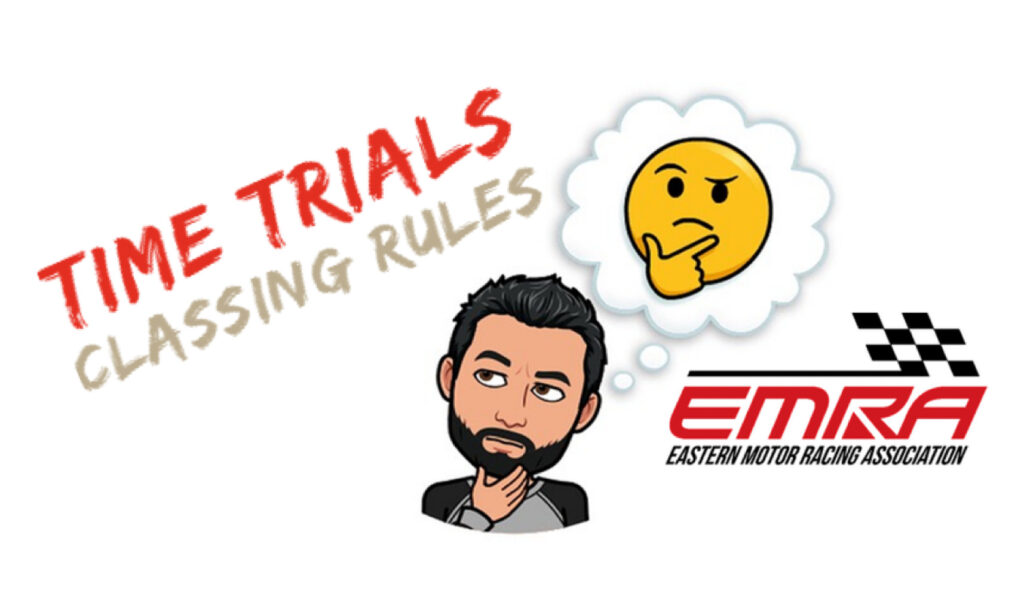
Learn Time Trials classing rules
Get behind the scenes on the original EMRA episode, when we dig deep and discuss changes to the Time Trials classing system, the legendary EMRA Enduro, and much more!
Special thanks to Cory Canzone (Chairman and CI) along with Jon Katz the (CIO/CTO) from EMRA for having this open debate and clarifying a lot of questions surrounding the difficulties of properly classing vehicles for competition.
Tune in everywhere you stream, download or listen!
 |  |  |
This episode was sponsored by the Eastern Motorsport Racing Association, the leader in timed events and grassroots racing since 1969. Learn more at emraracing.org and follow them on social media @emraracing.
Flag knowledge isn’t just procedural – it’s predictive. Eric walked through nuanced scenarios:
- A red flag should be followed by a black flag. Why? Accountability. Flaggers need to see you and bring you in.
- After a checkered flag, don’t slam the brakes. Maintain pace respectfully – others may be checking tire pressures or cooling down.
- Standing yellow = caution condition exists. Waving yellow = active caution. Know the difference.
- White flags can indicate emergency vehicles on track. Treat them as cautionary.
- Debris flags removed? Doesn’t mean the hazard is gone. Scan the track constantly.
Bonus tip: A pit-in signal (fist out the window) is an implied pass. Don’t sit behind a car that’s pulling off – go around safely.
Vocabulary of Speed
Instructors use concise commands: brake, wait, turn in, unwind, go. But they’ll adapt to your language. If “aim” doesn’t click, and “focus” does – expect your coach to switch. Communication is key, especially in mixed-skill groups.
Hand signals matter too. Point-bys must be clear and deliberate. Left arm = command. Over-the-roof gestures = pass on the right. And please, no T-Rex arms: Miata drivers, we’re looking at you.
Eric dove into seating and hand positions:
- 10 & 2, 9 & 3, or 7 & 4 (kart style) – pick what works, but no one-handed cruising.
- Shuffle steering vs. fixed grip? It’s not religious. Pre-positioning your hands for turns is often the best hybrid.
- Manual drivers: avoid “money shifts.” Overhand shifting can pull your elbow toward your hip, risking a wrong gear. Try palming or underhand techniques to push the shifter away from your body.
Track Etiquette and Setup
- No loose items in the car. Tether your GoPros.
- Consider a CG lock if you’re running stock seatbelts.
- Know your blend line. At tracks like Summit Point, it’s long and blind—cutting over early is a recipe for disaster.
- Smooth, confident inputs. No double braking. Commit to your actions.
Four Steps to Mastering a Track
- Orientation – First session: learn the layout, flag stations, and corners.
- Memorization – Second session: start building rhythm and consistency.
- Consistency – Predictable mistakes are easier to coach than random ones.
- Speed – Only after you’ve built consistency does speed come naturally.
Tire Pressure, Brake Pads, and the Myth of Modding
Eric’s advice? Start with the basics—and know them well.
- Tire pressures: Your cold starting pressure (say, 28 psi) should be based on what the tire gains during a session—typically 6–8 psi. Check pressures after cooldown, ideally during lunch.
- Brake pads: Street pads fade under heat. Race pads need heat to work. Autocross pads often strike the right balance for HPDE.
- Rotors: Fancy cross-drilled rotors look great at Cars & Coffee – but they’re prone to cracking under track stress. Racers prefer flat, solid rotors with maximum surface area.
Eric’s golden rule: “Trust, but verify.” That applies to torque specs, lug patterns, and even your buddy’s advice. Don’t overtighten lugs post-session – heat stress can snap studs. And don’t rush into mods. “Never mod past your abilities,” Eric warned. Learn to outdrive your equipment first.
Driving by Feel and Segment Strategy
Driving by feel is a skill – and a survival tool. Your body becomes the G-meter. Learn how weight transfer, tire feedback, and throttle inputs affect the car’s behavior. And remember: “More throttle and more steering is never the answer.”
Break tracks into segments. Stitch turns together. Think two or three corners ahead. Exit speed matters more than entry speed. And when it comes to trail braking – especially in front-wheel-drive cars – it’s an art form. Practice it slowly, build up confidence, and use it to rotate the car into the apex.
Racecraft, Passing, and Progression
Want to build racecraft? Go karting. It’s the best way to learn traffic strategy and passing etiquette. On track, passes should happen where wheels are straight – typically at corner exits. Make your intentions known. Sit in the mirror. Don’t tailgate, but don’t linger five car lengths back either.
Progression isn’t about rushing to the next run group. It’s about diversity of experience. Eric recommends six to eight different tracks before moving up. Learn from every venue. Stitch together your knowledge. And when you’re ready, seek mentorship – not just data. “Never stop learning,” he said. “Speed is always last.”


